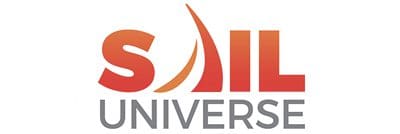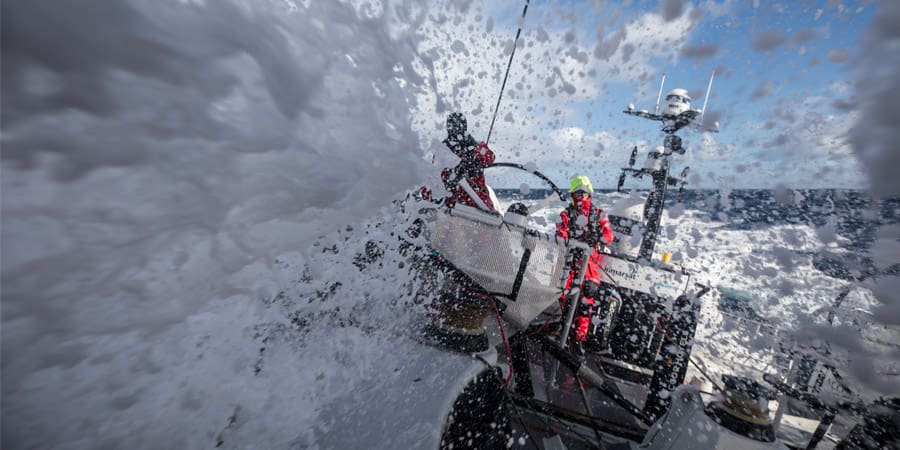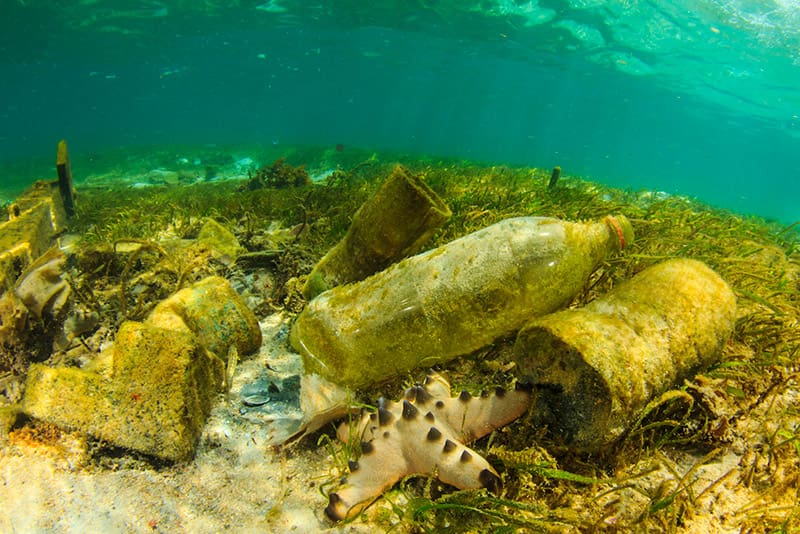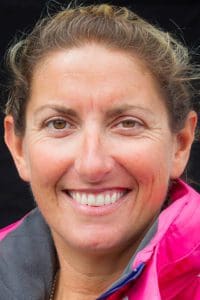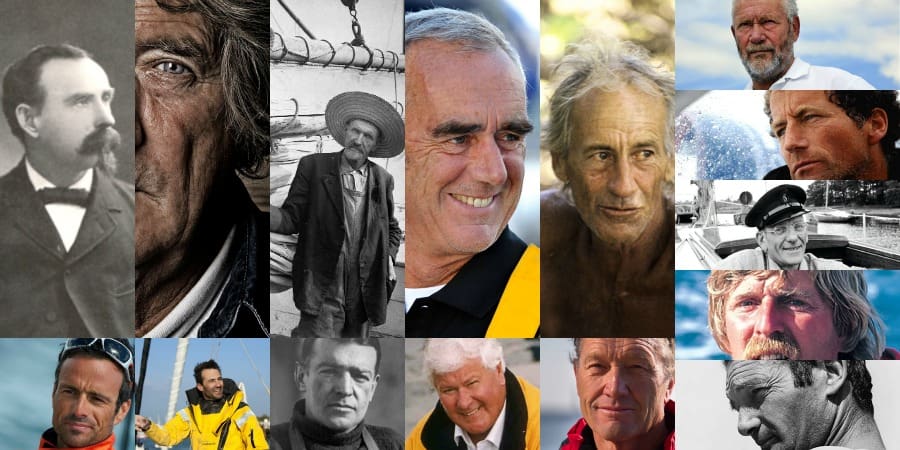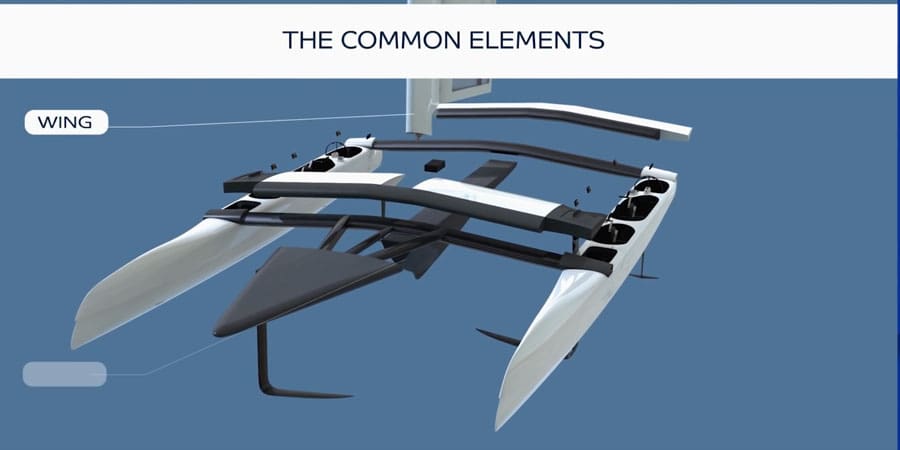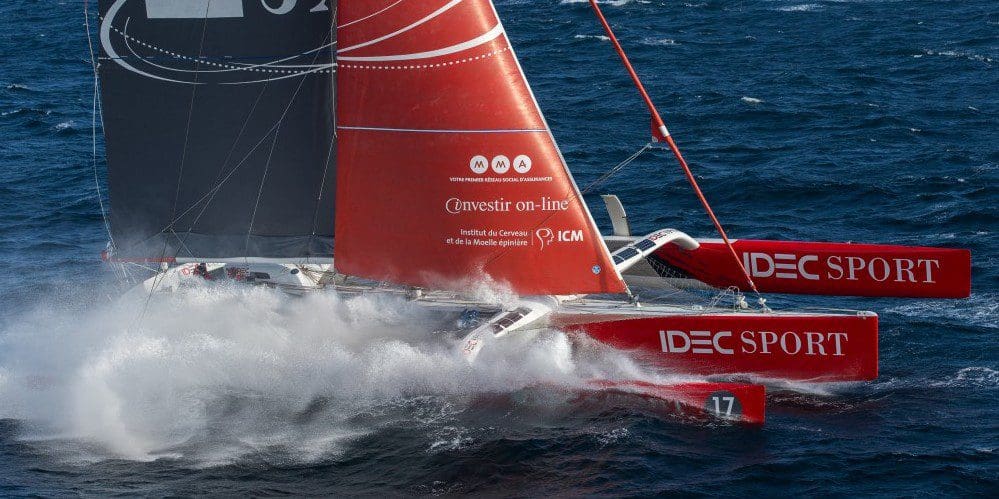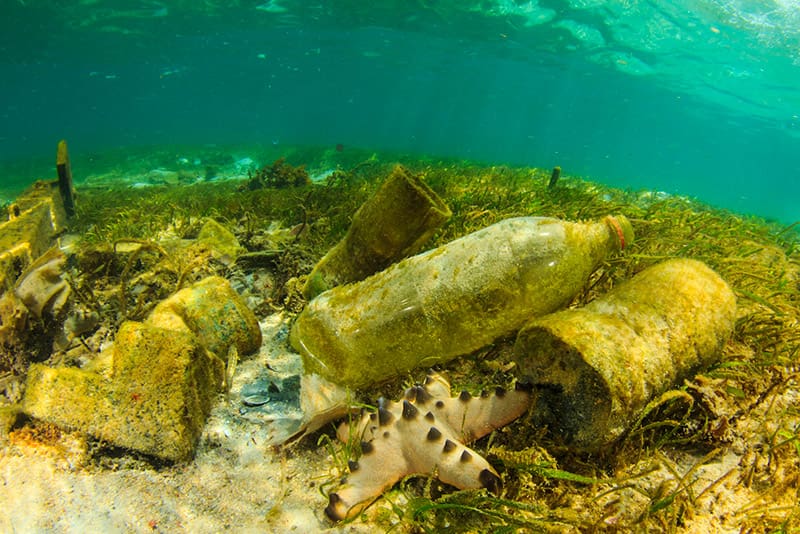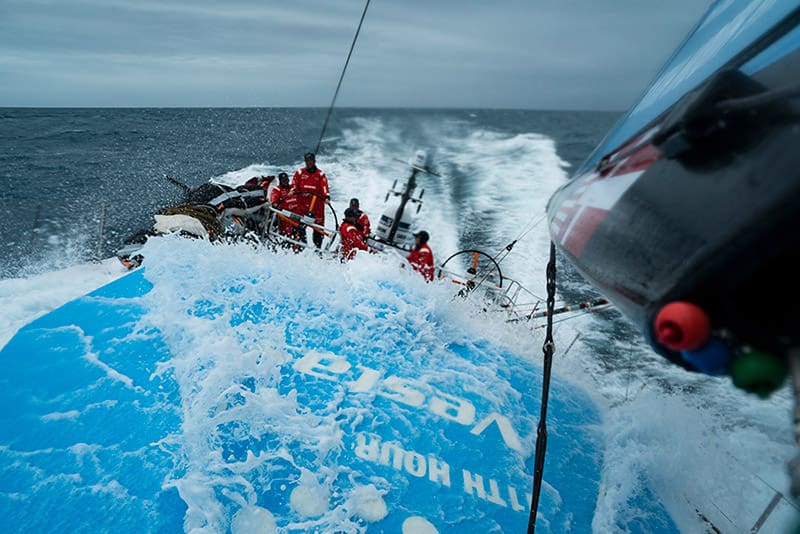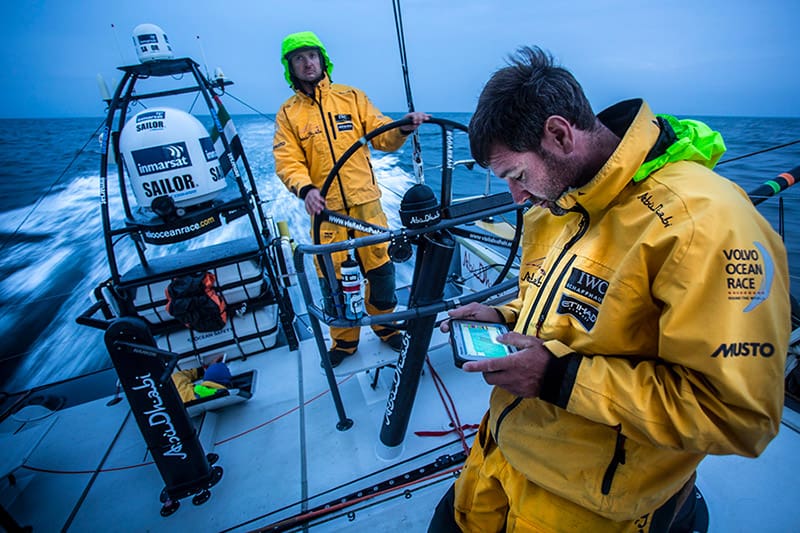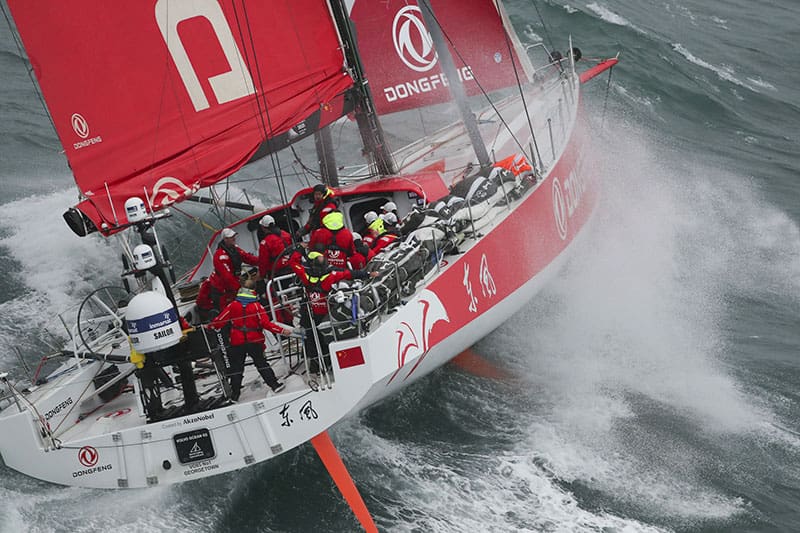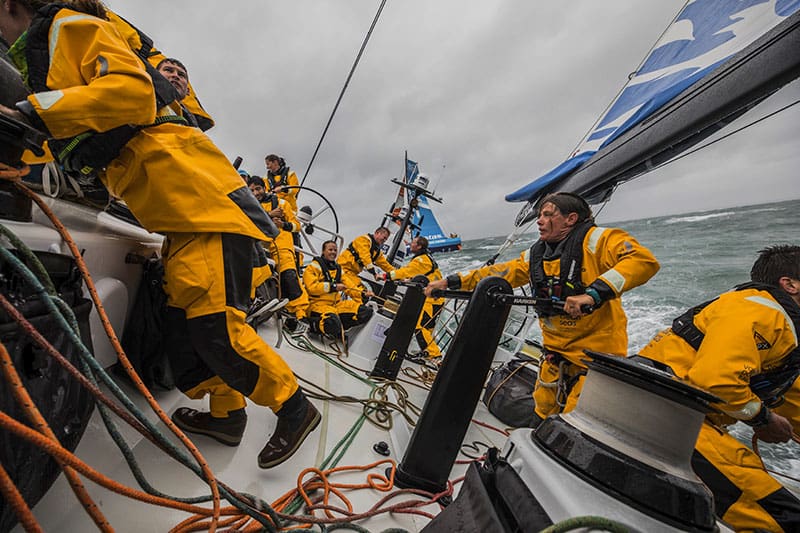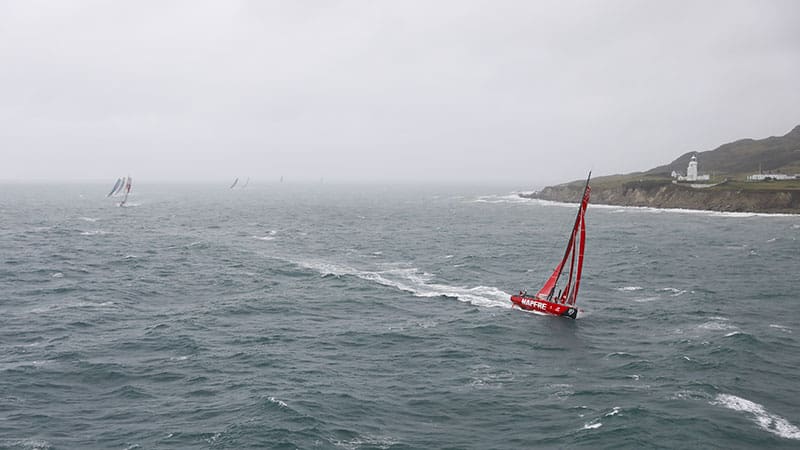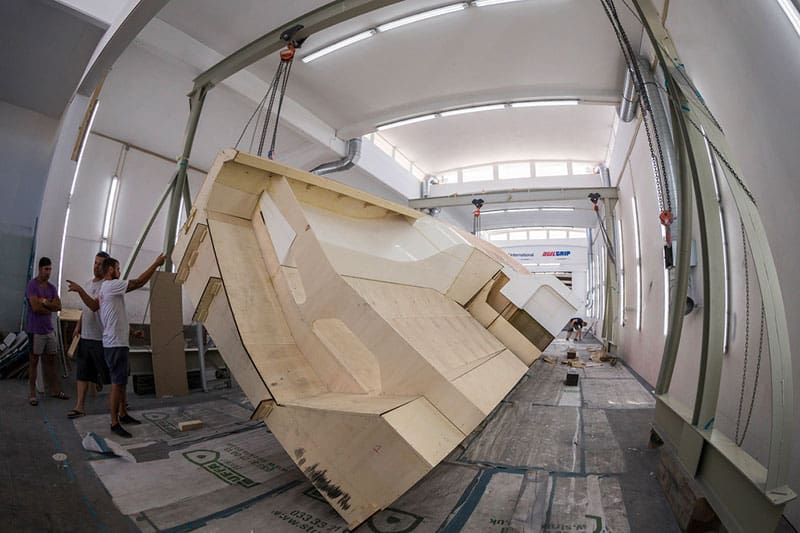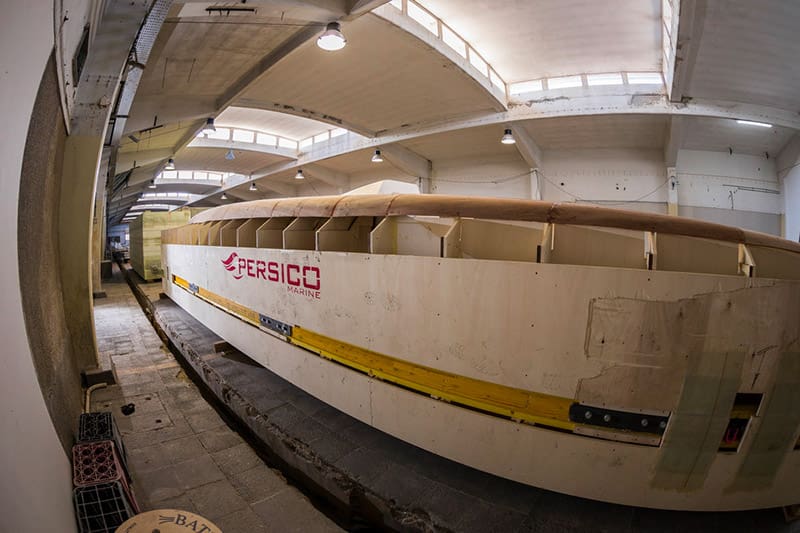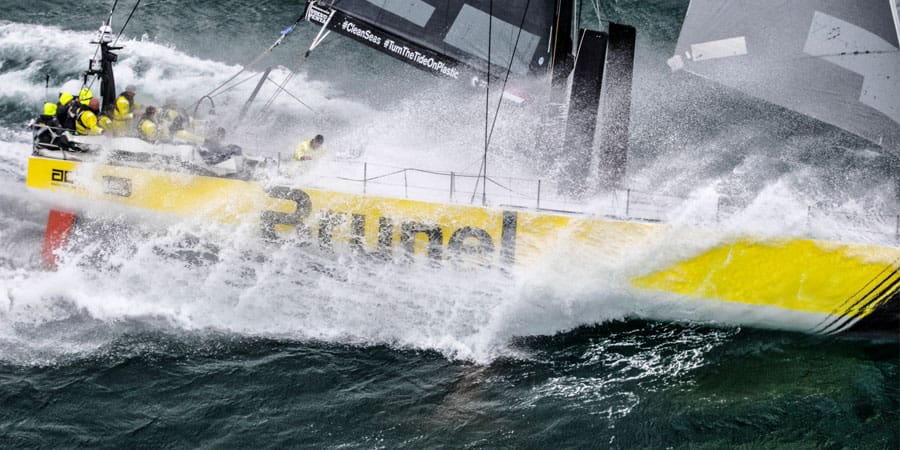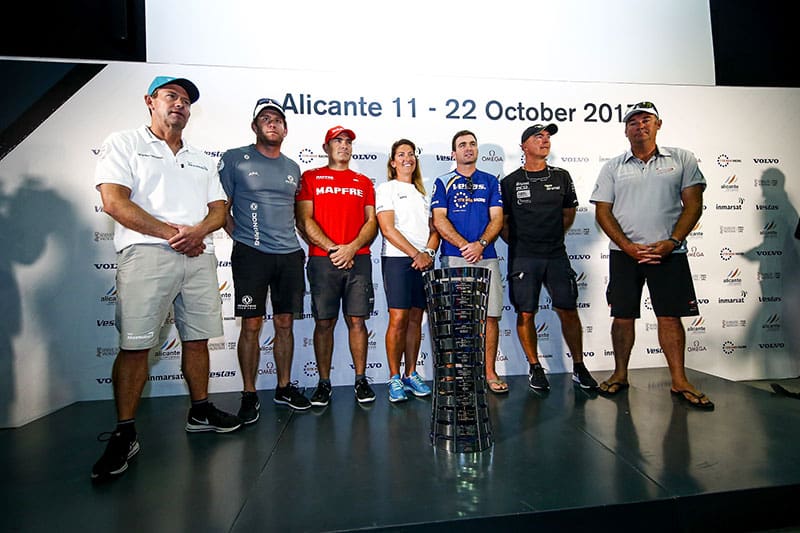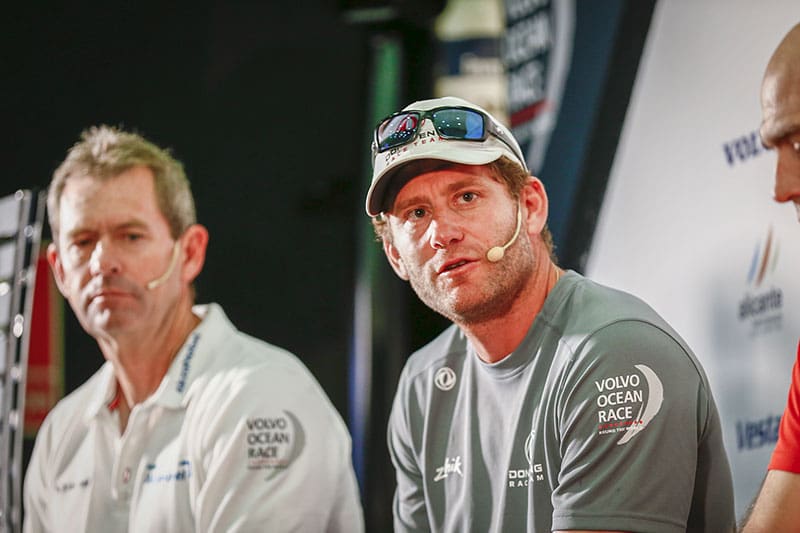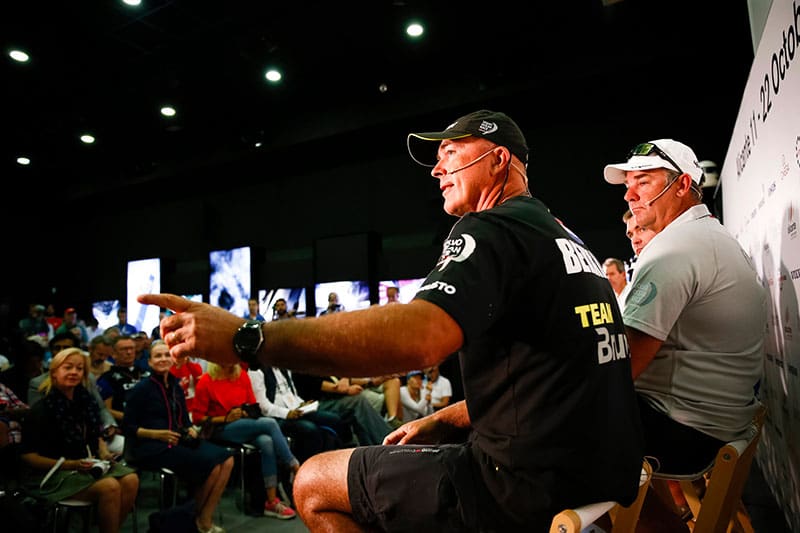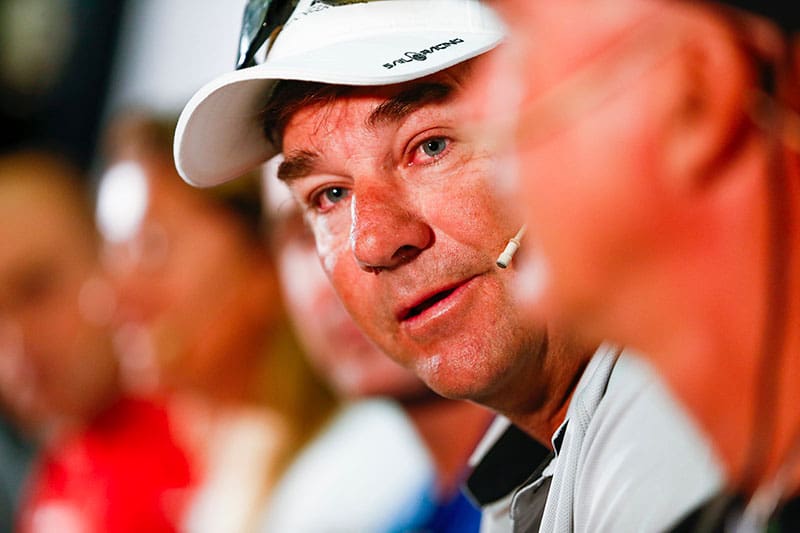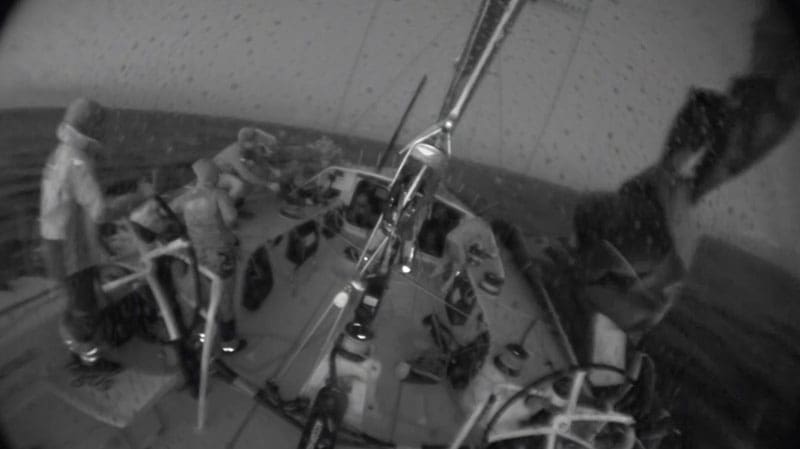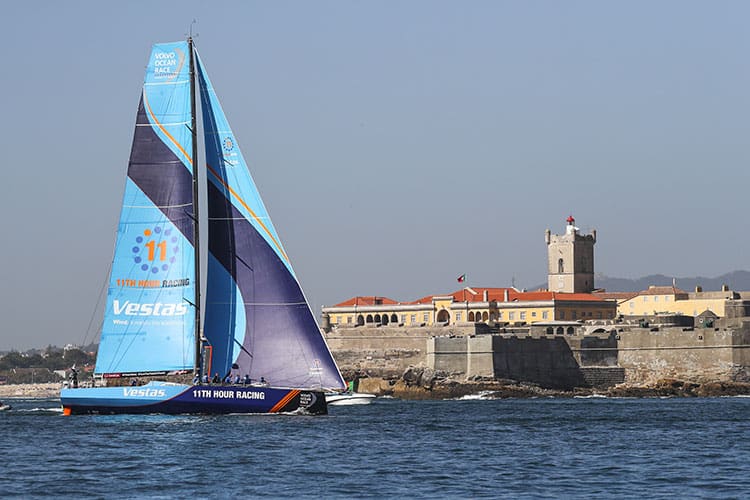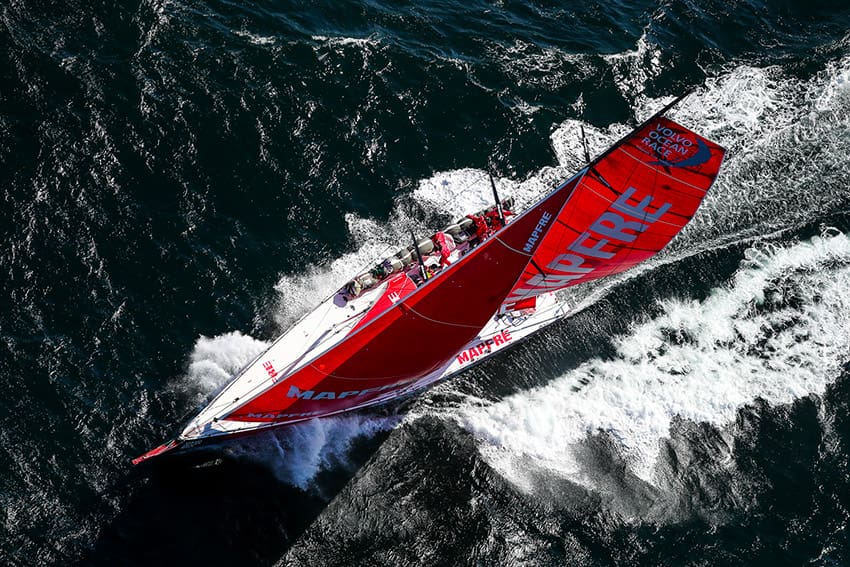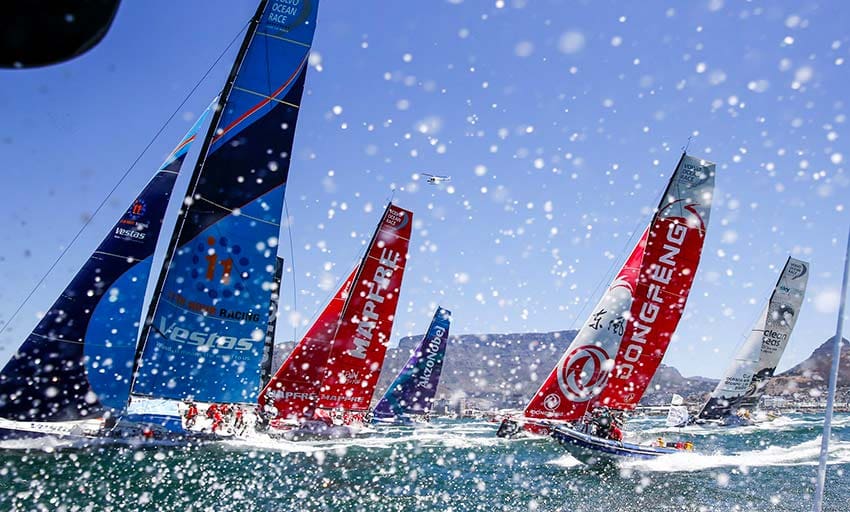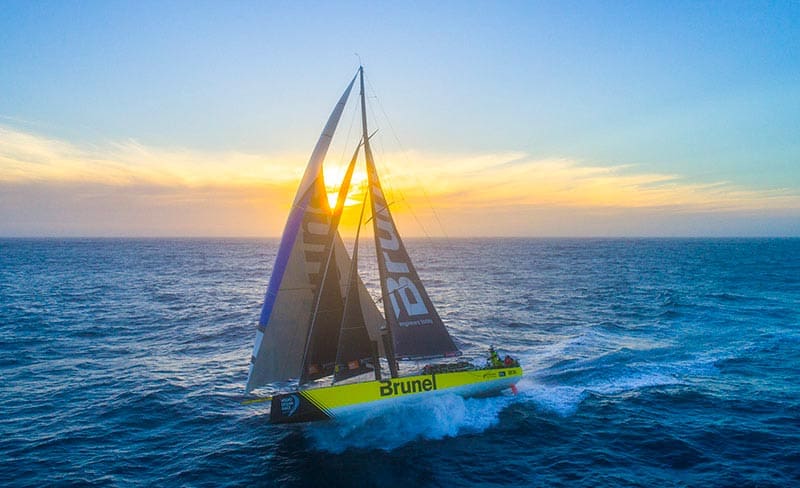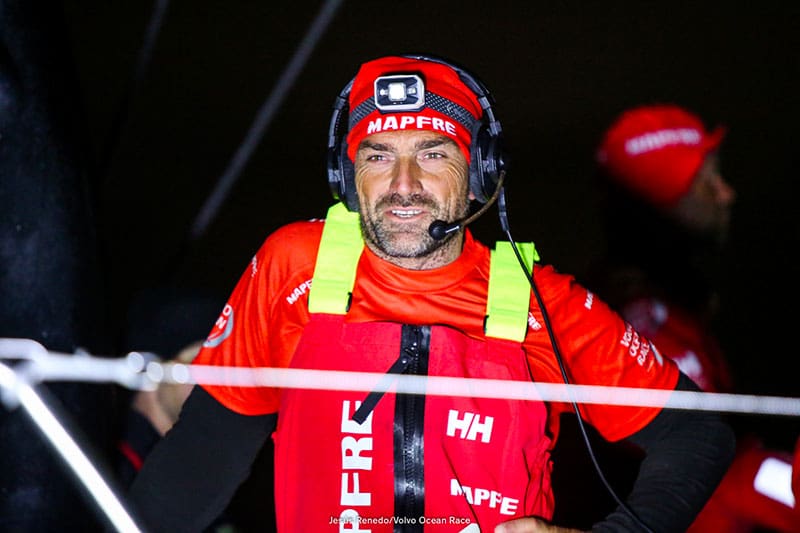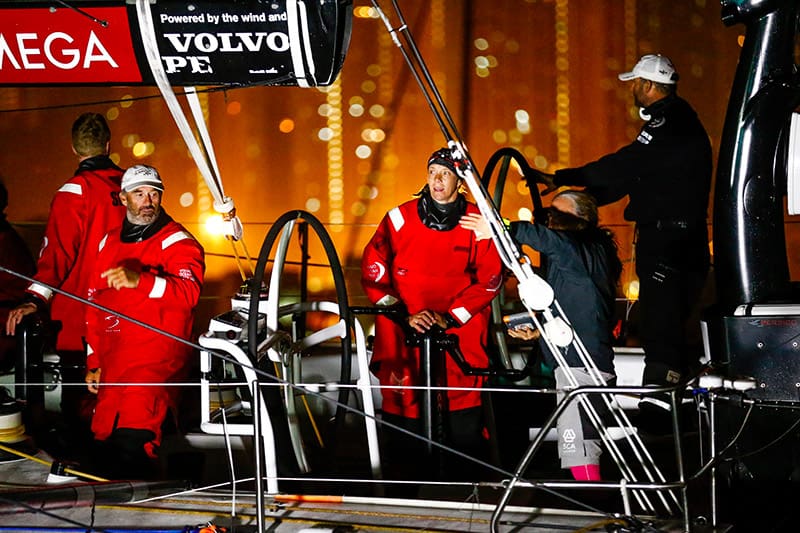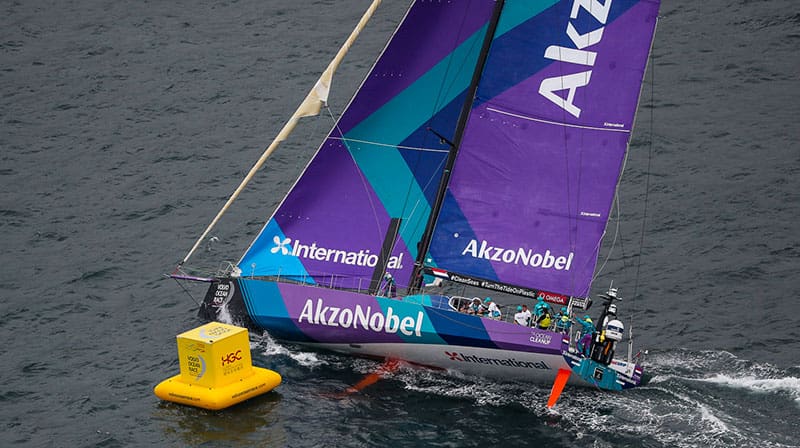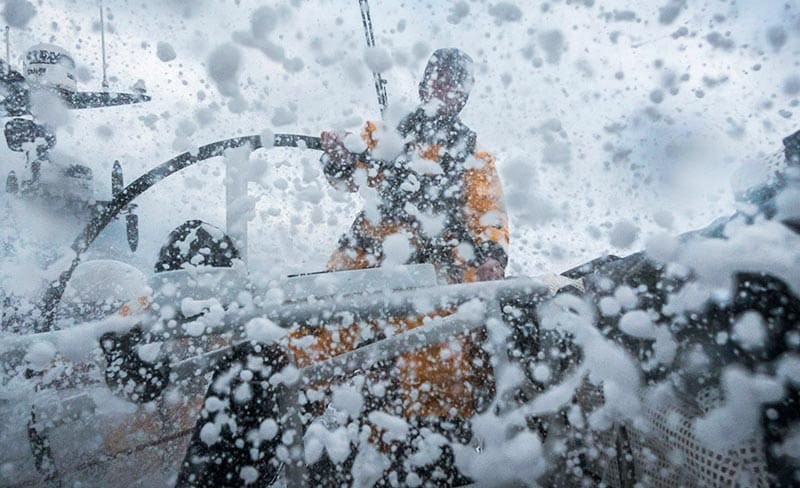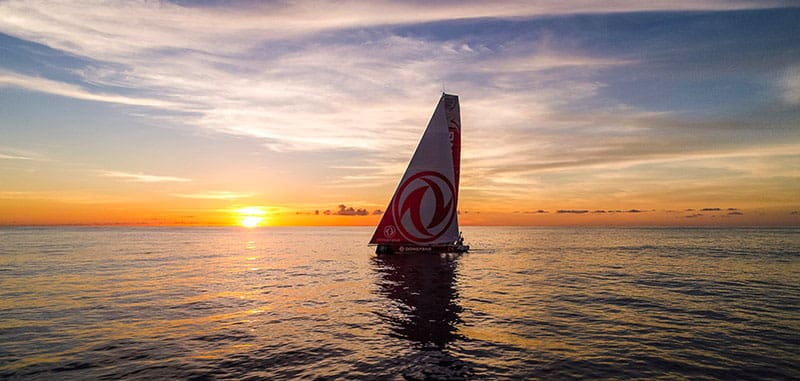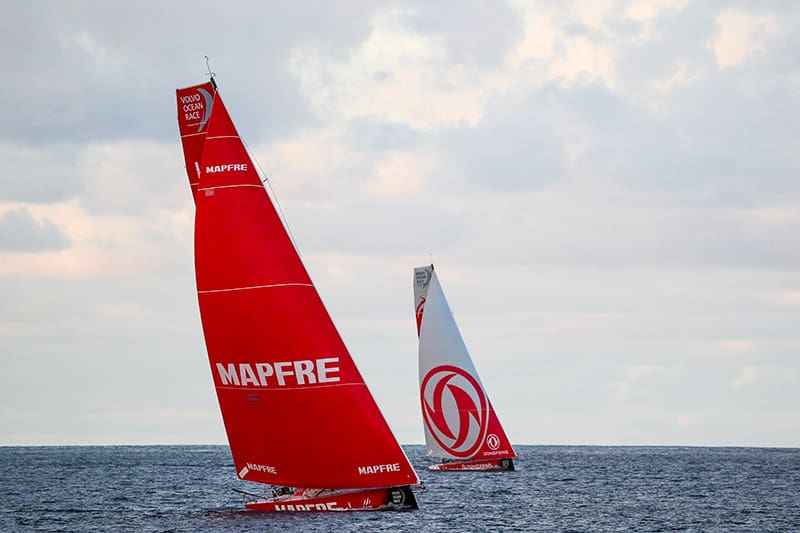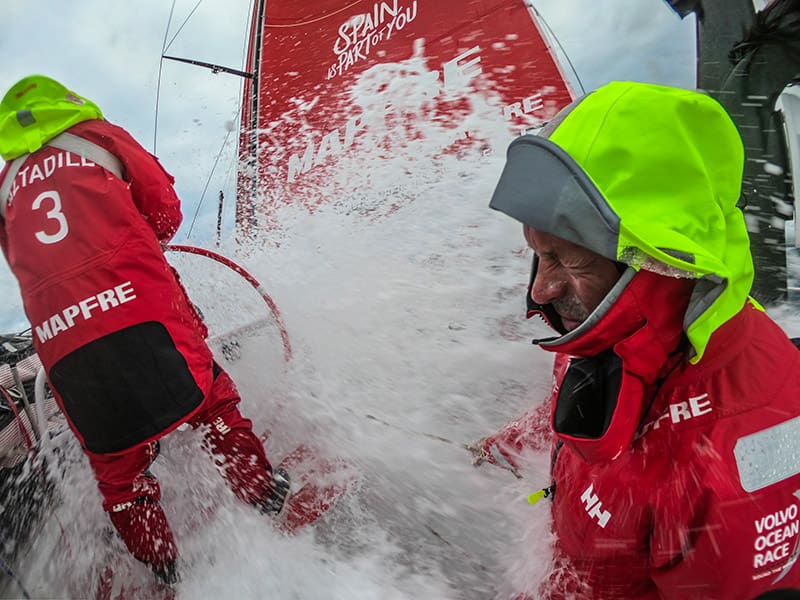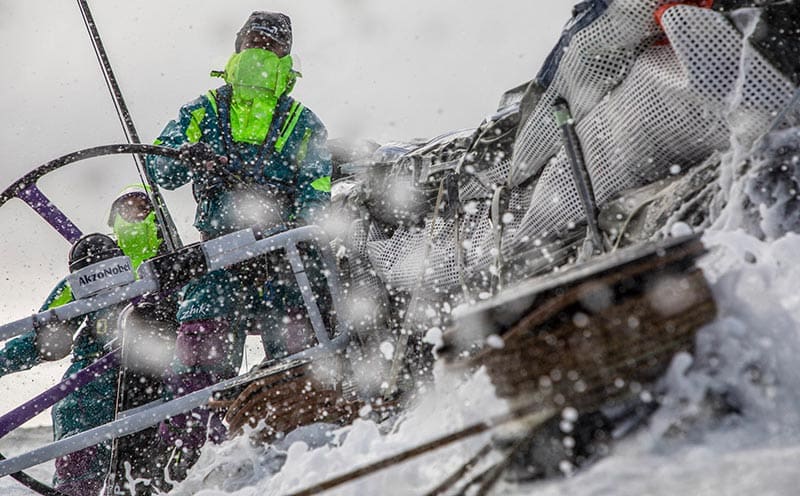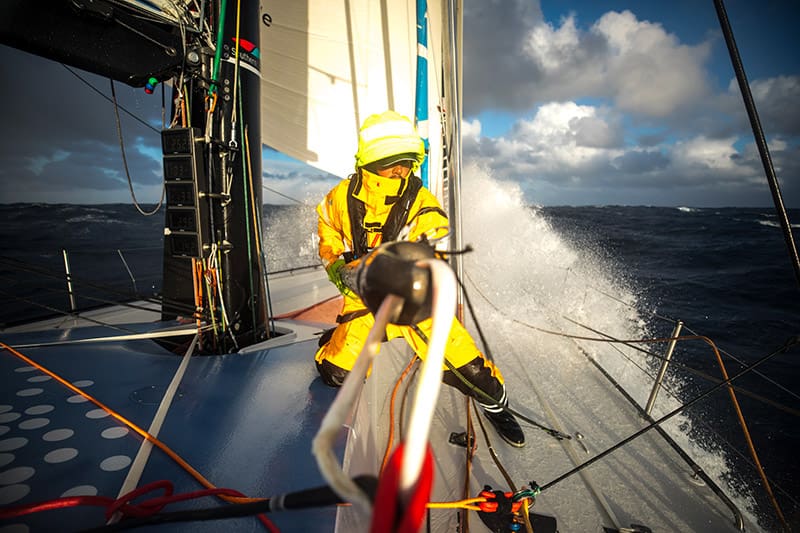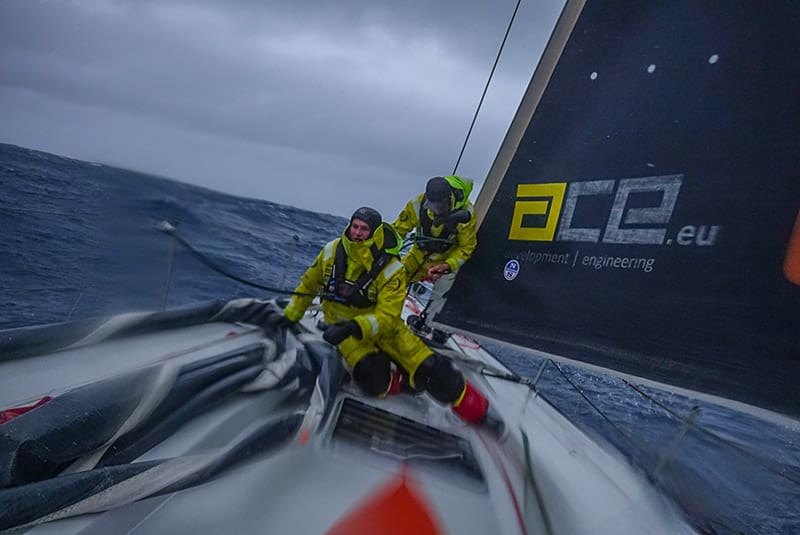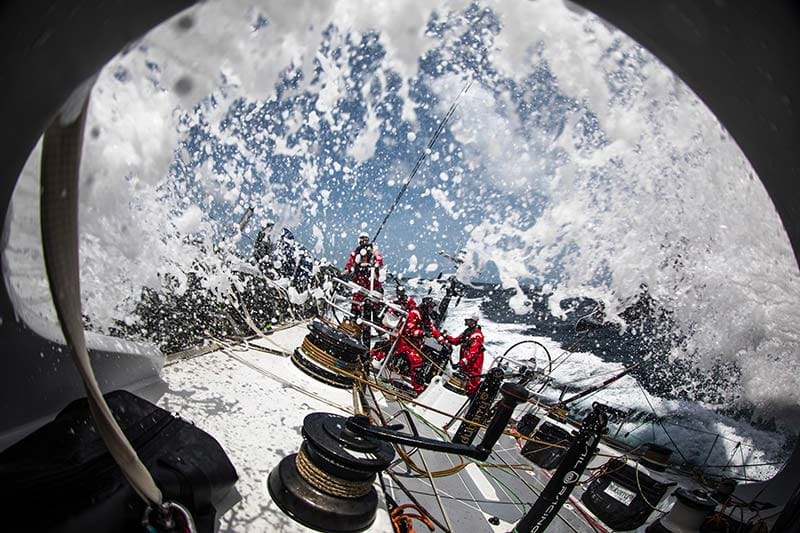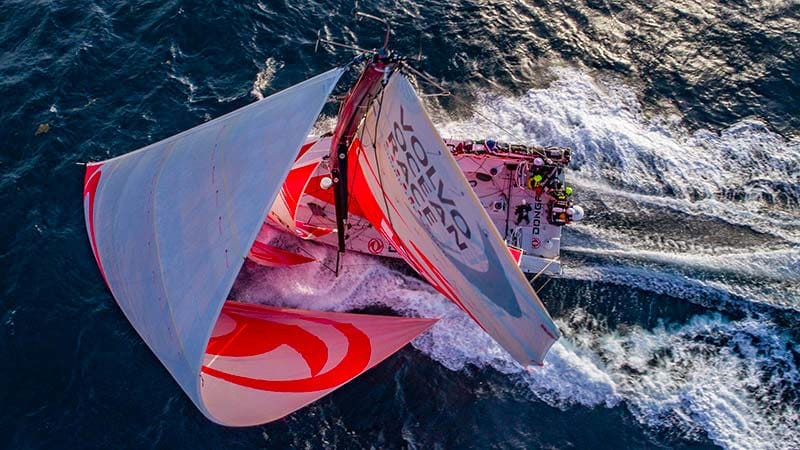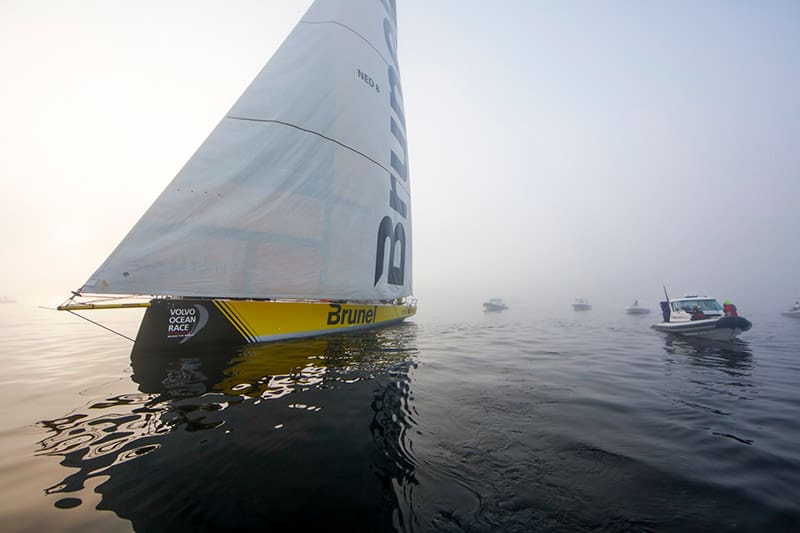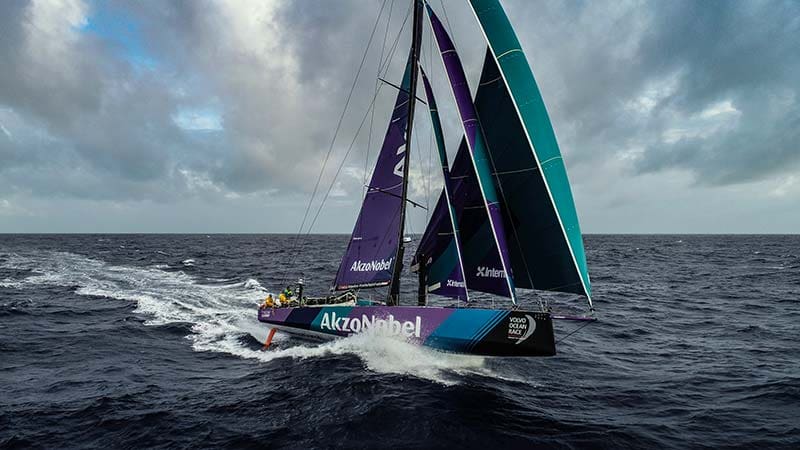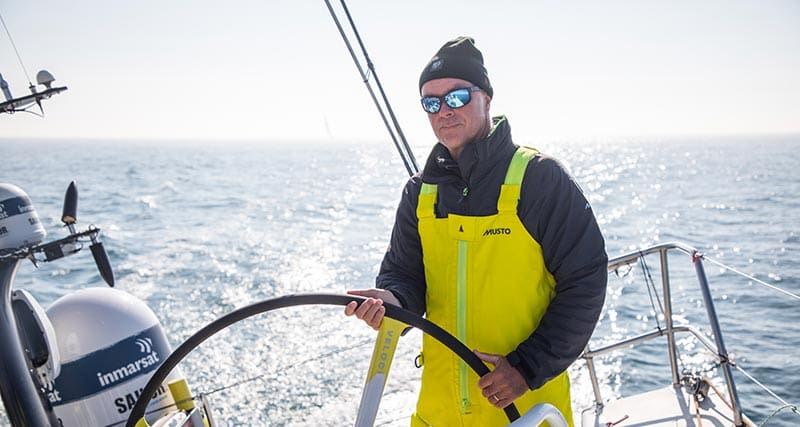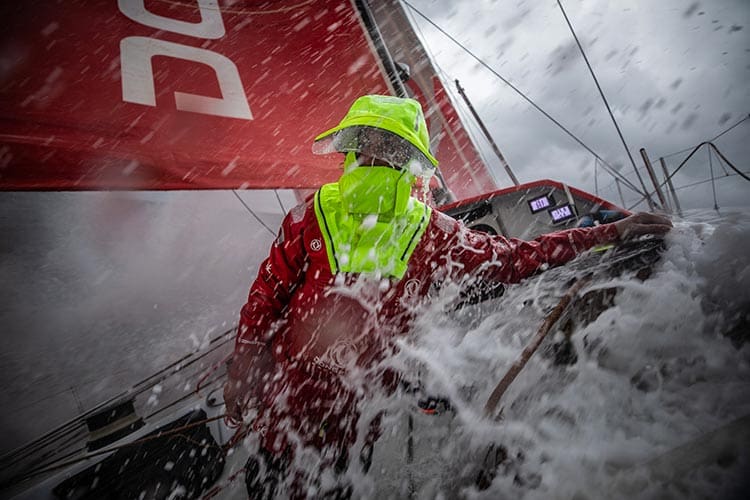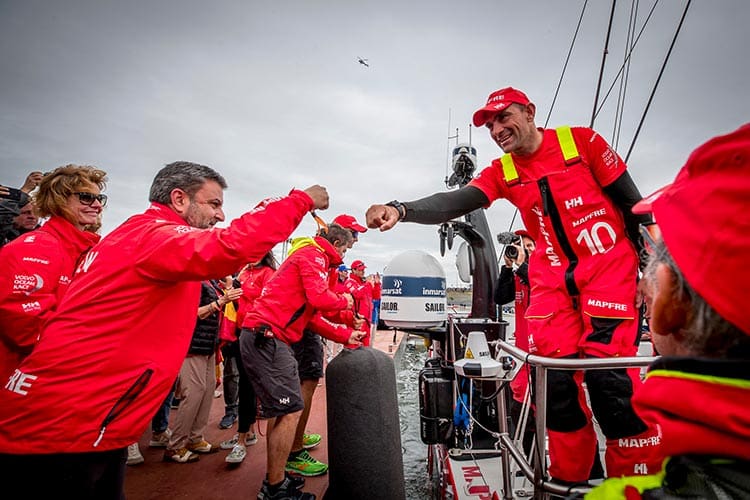Volvo Ocean Race 2017-2018 was one of the closest and most exciting ever – with the winner decided in the final five miles of the race following a 45,000-mile marathon slog around the planet. Here’s a look at the race in all its glory – the highs and lows – as the teams put everything on the line in a bid to win sailing’s ultimate prize.
Volvo Ocean Race 2017-2018: The Summary
14 June 2017
Dee Caffari will lead a youth team with a sustainability message
Britain’s Dee Caffari will lead ‘Turn the Tide on Plastic’ – a mixed, youth focused team with a strong sustainability message in the Volvo Ocean Race 2017-18. Her campaign, already backed by the Mirpuri Foundation and Ocean Family Foundation, is dedicated to the issue of ocean health.
The sixth confirmed team out of a possible eight for the upcoming edition will amplify United Nations Environment’s ‘Clean Seas: Turn the Tide on Plastic’ campaign throughout the eight months of the race, which covers 45,000 nautical miles of racing around the world, taking in 12 Host Cities on six continents.
Caffari’s ambition is to build a multi-national, 50-50 male/female squad, with the majority under 30 years of age. As part of the sustainability focus, the messages around diversity in age and gender will be strong themes of a campaign that in sporting terms may not start as a favourite, but could easily surprise on the water.
“I’m absolutely delighted to get the opportunity to sail for a cause I am so passionate about,” said Caffari, whose UK-based company will also run the project. “The Volvo Ocean Race is the ultimate test of a team in sport, and with the ambition to race with a youth-orientated international mixed crew, we are looking to make an impact on and off the water.”
Caffari’s team is already part-funded by the Mirpuri Foundation and Ocean Family Foundation (OFF), who join an increasing number of partners backing Volvo Ocean Race’s campaign on ocean health and sustainability.
The Mirpuri Foundation is a non-profit organisation set up by Portuguese businessman and philanthropist Paulo Mirpuri with the aim of making the world a better place for future generations.
In addition to raising awareness around the growing issue of ocean pollution, the partnership is part of the Mirpuri Foundation’s long-term ambition to build a new chapter in Portugal’s rich maritime history by creating a strong offshore legacy for future generations of Portuguese sailors. Caffari will include two Portuguese sailors in the team with a view to building a full Portuguese team in future editions of the iconic race.
“We feel immense pride to be backing this incredible ocean health campaign which we are sure will provide a great contribution to the health of our wonderful blue planet,” said Mirpuri. “We must act immediately if the next generation is to inherit seas and oceans which resemble those that we knew as children.”
15 July 2017
Vestas 11th Hour Racing unveils mixed crew for VOR 2017-18
Vestas 11th Hour Racing has unveiled their crew for the Volvo Ocean Race 2017-18 edition – and has built a mixed, ten-strong team featuring six nationalities and six previous Race wins.
The line-up features a wealth of experience, including Simon Fisher (GBR), who returns for his fifth Volvo Ocean Race appearance after lifting the trophy as the winning navigator with Abu Dhabi Ocean Racing last time out.
He is joined by two-time winner Phil Harmer (AUS), who is hunting a Volvo Ocean Race hat-trick following successive victories in the last two editions, five-time sailor Damian Foxall (IRL), who scored a win in 2008-09 onboard Ericsson 4, and Race veteran Tony Mutter (NZL), who returns for a sixth lap of the planet, having gotten his hands on the trophy twice in the past.
Tom Johnson (AUS), fresh from the America’s Cup as part of Team ORACLE USA, steps back onto a Volvo Ocean 65 after racing last edition onboard Team Vestas Wind – and Nick Dana (USA), who competed alongside Enright and Towill, returns to the Race for a second consecutive outing as a sailor.
For others, this will be their first round-the-world race. Denmark’s Olympic medallist Jena Mai Hansen joins Britain’s Hannah Diamond as one of two female sailors on board following successful trials during recent transatlantic trips from Lisbon, Portugal to Newport, USA.
“It was actually my first-ever full night at sea – an intimidating but amazing experience,” explained Hansen. “Helming a Volvo Ocean 65 boat in the middle of the Atlantic in pitch dark, in 40 knots, is without a doubt one of the craziest things I’ve ever done. I’m hungry for more and excited to be part of a skilled, international team. Bring it on!”
Between them, the crew has competed in the Volvo Ocean Race over 20 times – and skipper Charlie Enright says that he’s delighted with the preparations with just a few months remaining until the start line.
“We’ve taken our time to get this right, and we couldn’t ask for a better group of sailors,” he explained.
“There are 100 days left until the race kicks off, with some important team time along the way. I’m definitely satisfied that we’re in a good place and setting the team up with a solid chance of taking the crown.”
The team are currently preparing to travel to Gosport, UK, for pre-race activation and Leg Zero commitments, lining up against the other teams for the first time in the Round-the-Island race during Cowes week, followed by the Rolex Fastnet Race, and finishing up in Lisbon after sailing via St. Malo in mid-August.
Vestas 11th Hour Racing will be joined on the start line by Dongfeng Race Team (skippered by Charles Caudrelier), team AkzoNobel (Simeon Tienpont), MAPFRE (Xabi Fernández), Team Sun Hung Kai/Scallywag (David Witt), Turn the Tide on Plastic (Dee Caffari) and Team Brunel (Bouwe Bekking). The race departs from Alicante on 22 October 2017.
2 August 2017
MAPFRE blaze to record victory in the Around the Island Race
MAPFRE took first blood in the opening battle of the Volvo Ocean Race 2017-2018 fleet – with Xabi Fernández and his Spanish team finding faultless form to smash the established record time for a monohull around the Isle of Wight.
MAPFRE clocked 3 hours 13 minutes 11 seconds in strong conditions off England’s south coast to hold off Team Brunel and notch up victory in the Around the Island Race – the first in a series of four ‘Leg Zero’ tests acting as qualifiers for the Volvo Ocean Race 2017-18, which starts on 22 October.
The first four of the Volvo Ocean 65s – MAPFRE, Brunel, AkzoNobel and Dongfeng – were all, subject to ratification by the World Sailing Speed Record Council, under the fastest previous monohull time of 3:20, set by the super-maxi ICAP Maximus.
On a grey summer’s day in Cowes, scattered patches of drizzle couldn’t obscure the brightly coloured sails of the Volvo Ocean 65 fleet as the brass cannons of the Royal Yacht Squadron boomed out the first official start signal in the build-up to this edition of the Volvo Ocean Race.
MAPFRE brought their team’s Olympic experience to bear as they won the start handily, beating Vestas 11th Hour Racing and Brunel across the line.
With wind from the south between 15-20 knots at the start and gusts up to 35 knots, the boats flew down the Solent on the outgoing tide. The most recently announced team, and thus the team with the least miles in training, Dee Caffari’s Turn the Tide on Plastic was the only boat with a reef at the start. They were quickly joined by the rest of the fleet as the wind built during the drag race down the Solent.
After the southern point of the island the Volvo Ocean 65s were finally able to bear away onto their favourite point of sail, with navigator Joan Vila perfectly choosing MAPFRE’s course and sail changes.
There was no surprise that all the top teams around the back of the island had done the previous race, with MAPFRE leading Dongfeng and Brunel. Bouwe Bekking’s strong performance demonstrated that despite only a week’s training before today, and crew trials still underway, the 39,000 miles sailed in the 2014-15 edition are worth gold.
The boats will now regroup in Gosport as a final opportunity to prepare for the Rolex Fastnet Race, the second stage of Leg Zero, starting on Sunday. After the Fastnet, the teams complete Leg Zero by sailing from Plymouth to St Malo and then on to Lisbon.
Race Results
1. MAPFRE: 3 hours 13 minutes 11 seconds
2. Team Brunel: 3 hours 14 minutes 55 seconds
3. team AkzoNobel: 3 hours 15 minutes 16 seconds
4. Dongfeng Race Team: 3 hours 18 minutes 26 seconds
5. Turn the Tide on Plastic: 3 hours 24 minutes 16 seconds
6. Vestas 11th Hour Racing: 3 hours 25 minutes 10 seconds
7. Sun Hung Kai/Scallywag: 3 hours 29 minutes 53 seconds
25 August 2017
First Look at Foil-Assisted Volvo Ocean Race New Boats
Just over three months ago, on 18 May 2017, Volvo Ocean Race CEO Mark Turner stood on a stage in the Volvo Museum in Gothenburg and announced that the question of whether the future of the race was monohull or multihull had been solved.
In fact, the Volvo Ocean Race had opted for both – and would design and build a one-design foil-assisted 60-foot (18.29 metre) monohull for the ocean legs, and a one-design 32-50 foot foiling catamaran (10-15 metre) for use inshore at the stopovers.
Now, with the 2017-18 edition already apace following a thrilling Leg Zero, work on the two new boats has been moving very fast in the background.
This week, the first mock-up of the Guillaume Verdier-designed offshore monohull was revealed at the Boatyard in Lisbon – and it looks incredible.
“We contacted several designers and asked them to submit their ideas for both a complete stand-alone Volvo Ocean Race boat, or with the potential to convert to an IMOCA boat,” said Bice.
“All the designers that we invited to present were very strong, it wasn’t clear cut – we had some pretty serious soul-searching to decide what we wanted to do. I went to New Zealand and spent a day with Guillaume to get to know him, and we decided he was our man.”
Verdier recently came to prominence as a designer for the foiling 2016 Vendée Globe boats, and for the 36th America’s Cup winners, Emirates Team New Zealand.
“We’ve created the Volvo Ocean Race Design Team as a collaboration, getting the best input from everywhere,” said Bice. “It’s going to be a very cool boat; imagine coming into the finish, in a harbour in 20 knots of breeze and you are going to see this thing fully airborne, foiling, at 35 to 40 knots.”
Verdier has now gathered his team around him, and they have been working hard on the hull lines. The design has developed in a way that will enable IMOCA 60 compatibility, making it convertible, relatively quickly and inexpensively, to a short-handed rules-compliant IMOCA boat for events like the solo Vendée Globe and two-up Barcelona World Race.
“We don’t think there is any compromise to making a stand-alone Volvo Ocean Race boat comply with the IMOCA 60 rules. Although in Volvo mode, we will have another keel, we will have different rudders, foils, we will have a different rig on it,” said Bice.
“So now, with the new two-year race cycle, a team can compete in an IMOCA event in between, maintaining profile for a sponsor and making it much easier for them to commit to two cycles of the Volvo Ocean Race. That’s what we want to try and achieve.
7 October 2017
Prologue Leg to Offer Final Tune-up Ahead of Race Start
It’s a final chance for teams to lock in crew configurations and get in some speed testing against the competition ahead of the start of Leg 1 on October 22 in Alicante.
“This is the last opportunity for all of the boats to face each other before we start,” says Mark Towill of Vestas 11th Hour Racing. “We’ll be lining up against the other teams to check the things we’ve learned during testing compared to the rest of the fleet.”
Towill and his team have been training against team AkzoNobel. The Dutch team’s Luke Malloy spoke of the benefit from the sessions.
“The two boat training sessions we did with Vestas 11th Hour Racing were definitely very valuable and actually quite eye opening in a few areas,” he confirms. “Just to check on some of our sail crossovers and lock down what we think we know in some other performance areas.”
Turn the Tide on Plastic skipper Dee Caffari says she’ll be giving some of her crew who have less offshore miles time on board during the Prologue, as her team makes the transition from training to competition.
“It’s an opportunity to get back into race mode,” she says. “It’s almost a practice of Leg 1, because we’re going from Lisbon to Alicante and that’s going to be the reverse for Leg 1 so it’s nice to suss it out.”
Team Sun Hung Kai/Scallywag, disappointed with its results this summer during Leg Zero, will be racing with some new crew members and navigator Steve Hayles says the team will be looking to bed in improvements made during practice over the past month.
“I think (on Leg Zero) everything was sub-par, so this is a good chance to put into effect everything we’ve been doing since. We’ve been sailing hard, we’ve done at least as many miles as anyone else, and so this is a good opportunity to cement those changes. Nothing is as good a measure of where you stand as going racing and hopefully we’ve made a big step up in our team performance.”
Rob Greenhalgh, about to embark with the Spanish team MAPFRE on his fifth Volvo Ocean Race, is looking forward to this final look at the opposition.
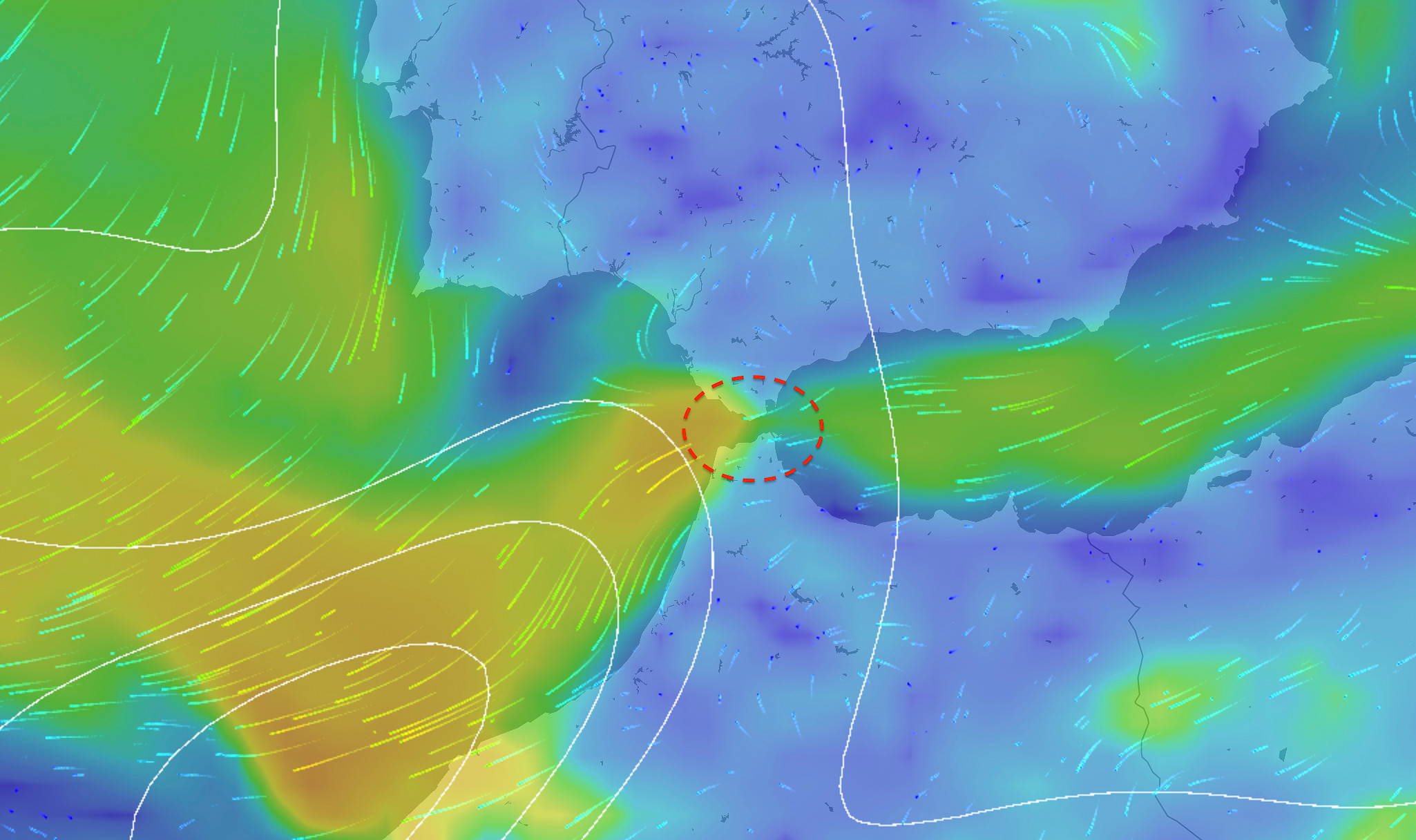
“It’s pretty important. Everyone’s going to be keen to check in,” he says. “We’ll be keen to race properly… we won’t be backed off. We’ll be going for it!”
Dongfeng Racing team director Bruno Dubois will see his team leave the dock in Lisbon satisfied they have done what they need to do to be ready to race by the start of Leg 1.
“My objective was to make sure we put everything in place and didn’t leave anything to chance,” Dubois explains. “We made a plan and we’ve stayed to it. Maybe someone is going to head out in Leg 1 and be very fast, but we’ve done what we needed to do to make our boat ready and fast for the start of the race. After that, well, it’s a long race.”
The weather forecast offers a mixed bag that will get the wrinkles out of all the new sails the teams have installed in Lisbon. Crews will face a light wind start in the Tagus River before a gentle run down the coast to Cape Saint-Vincent, the South West corner of Portugal. The light wind sails will stay up for the reach towards the Gibraltar Strait where the real action starts.
The boats will race upwind through the Gibraltar Strait early on Tuesday morning against the infamous Levanter easterly wind that could accelerate to over 30kts, all while penned in by a narrow coast, heavy shipping exclusion zones and coastal fishing nets. Forced into a 1.5-mile wide channel, skippers will be balancing the desire to push for a good result in their last warm-up versus the need to protect new sails that need to last 45,000 miles around the world.
After the Gibraltar Strait, the fleet will continue upwind through the Alboran Sea along the south Spanish coast in an uncomfortable sea state created by fresh easterlies running over the permanent eastwards current created by the Atlantic flowing into the Mediterranean. Turning northwards by Cabo de Gata, the wind is expected to drop to just 5 knots from the east, pushing the homecoming in the Alicante race village deep into Wednesday evening.
“We heard all the stories about how the Race Village in Alicante is nearly ready and everyone is waiting for us to arrive,” Caffari says. “And I know from the moment we arrive, the circus begins and it is pretty much non-stop. The time will fly by and we’ll be crossing that start line and heading away from Alicante for Leg 1 in no time.”
13 October 2017
Volvo Ocean Race: the Numbers Behind the Myth
The Volvo Ocean Race 2017 will start in less than 10 days. Waiting for this new edition, take a look at these numbers to understand we the VOR is the greatest race around the world.
Volvo Ocean Race history:
- The first edition of the race was staged in 1973-74. A total of 19 teams entered and the course took them 27,000 nautical miles around the world over four legs: Portsmouth-Cape Town-Sydney-Rio de Janeiro-Portsmouth.
- There have been 12 editions of the race to date, staged every four years at first, before the cycle moved to every three years from 2008-09.
- Volvo Car Group and Volvo Group have been owners and title sponsors of the Volvo Ocean Race since the 1997-98 edition.
- 167 boats have taken part in the 12 editions of the race to date.
- 43 different nationalities have been represented.
- The one-design Volvo Ocean 65 monohull was introduced for the 2014-15 edition. The same seven boats from 2014-15 will be used again in the next race after an extensive refit process at the Volvo Ocean Race Boatyard facility in Lisbon. An eighth boat is being built at Persico and will be raced in 2017-18.
The 2017-18 edition:
- At 45,000nm, this will be the longest course in the history of the race (previous longest racecourse was 39,270 in 2011-12.).
- It will feature almost three times as much Southern Ocean racing, around 12,500 nm, as in recent editions.
- It will cross four oceans and take in 12 major cities: Alicante, Lisbon, Cape Town, Melbourne, Hong Kong, Guangzhou, Auckland, Itajaí, Newport RI, Cardiff, Gothenburg and The Hague.
- The Race will start on 22 October 2017 from Alicante and finish eight months later in The Hague.
Women in the Volvo Ocean Race:
- For the 2017-18 edition, the race has introduced rules that give teams a major incentive to include women as well as men.
- All-male teams will be limited to seven sailors for this edition, but teams can also name 7 men plus 1 or 2 women; 5 men and 5 women; or 11 women on an all-female crew.
- 126 women have competed in the race since 1973, including 11 in the first edition.
- Clare Francis became the first female skipper in the 1977-98 race.
- Tracy Edwards and her crew of Maiden became the first all-female team to compete in 1989-90.
- Since then a further four all-female teams have competed – 1993-94 US Women’s Challenge (Nance Frank/Dawn Riley); 1997-98 EF Education (Christine Guillou); 2001-02 Amer Sports Too (Lisa McDonald née Charles); 2014-14 Team SCA (Sam Davies).
- No women competed in the race in 2008-09 and 2011-12.
21 October 2017
Seven skippers. One goal. “We all want to win”
The ultimate test in team sport, the Volvo Ocean Race, starts on Sunday, when seven of the best sailing teams in the world cross the starting line off Alicante, Spain.
The Volvo Ocean Race 2017-18 will test the crews on a 45,000 nautical mile race course, through some of the most challenging waters in the world, including more miles in the extremes of the Southern Ocean.
On Friday, the seven skippers faced the international media at the opening press conference. Here’s what they said, in their own words:
Charles Caudrelier, skipper, Dongfeng Race Team, comparing his preparation for this race, to last time: “Last time, when we started the project, we were in China meeting Chinese sailors who had never spent a night offshore, and teaching them how to sail. This time we started in Lisbon, with a team I already know. Since the beginning we are 100-percent focused on the performance. That makes a big change.
What’s the difference between doing the race as crew and skipper? The salary (laughing). There’s also the responsibility, of course. When I did the Volvo Ocean Race with Groupama, when I arrived at every stopover my mind was able to switch off. This time, throughout 9 months you never stop. The big pressure never stops. But I have a strong team around me so I’m a lucky skipper I think.”
Dee Caffari, skipper, Turn the Tide on Plastic, comparing sailing single-handed to fully-crewed: “In terms of sailing around the world solo or with a team, it makes a big difference when you have people to share it with and you have more pairs of hands when things happen. The intensity is the thing that gave me the buzz in a team environment, and knowing that you’re pushing 100-percent all the time. Your peers around you punish any mistake you make. It’s that intensity that attracts me.
“Everyone talks about Turn the Tide on Plastic as inexperienced. A lot of my sailors are first timers but they are very skilled sailors and they can make a boat go fast. We just need to make sure we don’t make any mistakes, and that we sail to the right place. Dee Caffari
Dee Caffari
“To create an opportunity for young sailors to sail in the Volvo Ocean Race and see them grow and blossom is a great privilege – as well as getting to spread a great sustainability message.”
David Witt, skipper, Team Sun Hung Kai/Scallywag, on his motivation for doing the race and his teammates: “It’s the best team sport in the world, I think. I got a good commercial offer – and I couldn’t find a better way to lose weight!!
“As has been recorded, I’m a lunatic but I think we’re all lunatics together. The young kid (Ben Piggott) started sailing dinghies with me three years ago and ended up here. He’s still dreaming.
“Right now, I’m finding it harder to stay on shore and stay out of trouble. As long as you have good people around you, it’s fine, and it’s safer on the boat then any other race I’ve been in.”
Brad Jackson, skipper, team AkzoNobel, on taking over as skipper in the week before the start: “Team-wise, we’re just focusing on the race. Basically, we have the same team as we had before except (without) Simeon. It’s thanks to him that we have the team we have. Not too much has changed in terms of how we’re going to work on board or the crew morale. The last few days we’ve been able to focus on what we’re going to do.
“We were lucky that Rome Kirby was available and qualified and ready to go. He’s another Under-30 so that brings us up to 5 Under-30s in the team. It’s a young team but Rome has done the race before with me on PUMA and he has a lot of experience for a young guy. He’s a young, fast guy. Brad Jackson
Brad Jackson
“I’m in this role because it’s necessary, for sure. It hasn’t been a dream of mine to be a skipper. It’s not something I’ve felt the need to do, but the situation has arisen and I’m happy to take it on. I wouldn’t t do it if I didn’t think I had the full support of my team. I hope I enjoy it, I hope it goes well, but it’s not something I’ve been pushing for, or jumping around, saying, ‘Pick me! Pick me!’”
Xabi Fernández, skipper MAPFRE, on being tabbed the favourite based on pre-race results: “For us it’s not about being the favourites. That’s not something we talk about, but we do realise that people think that way. It just makes me think we are ready. We have to sail as fast as we can. I think we are ready but I know these guys around us, on the other teams, are going to be ready as well.
“Hopefully, we can win. I don’t know. We’ve been close before and it didn’t happen. We know how difficult and long it is to win the race.”
Bouwe Bekking, skipper, Team Brunel, on why he keeps coming back and how he recruited his team: “It’s the best thing you can do… Everyone sitting here is a competitor and a sportsman. We all want to win. We have a very good chance of winning this competition.
“We were late at the table but that actually gave us an opportunity. The America’s Cup had just finished. I was racing on the J class and bumped into Carlo Huisman, who had been sailing on Team New Zealand. Through him I got in contact with Pete Burling and the next thing I knew we had the golden boy on the team. He’s won the Olympics, won the America’s Cup, and we also have Kyle Langford, who won the Cup twice.
“The America’s Cup sailors approach the race differently from us, the old school guys. They have a great intensity, and they look hard at everything to do with performance.”
Charlie Enright, skipper, Vestas 11th Hour Racing, comparing his youthful team in the last race, to the experienced crew he has now:“We’re still a young and fresh team. The last time, youth was our thing. Having been around the planet now we’ve logged a lot of miles and we’ve added some crew with a lot of experience. We showed a lot of improvement in the last race from the start in Alicante to the finish in Gothenburg and we want to maintain that trajectory. We won the last leg of the last race and we want to do the same here.”
Speaking about the rule change for 2017-18 incentivising the inclusion of female sailors:
Bouwe Bekking: “It’s great for sailing in general. It would have been very nice to choose our own team but as soon as the rules came out, I said we have to have 2 girls on board. We’ve got the best two girls we can. Abby Ehler is our boat captain and Annie Lush running the sail department. They’re great sailors with serious roles.”
Xabi Fernández: “I guess like Bouwe, new rules are always scary but we trialled some people. We have Sophie Ciszek, who sailed on Team SCA. She knows the boat, is very strong, does the bow and is very complete. And we trialled Támara very hard. She’s very talented and comes from the Olympics, having won gold in London. It was harder for her but I’m very pleased that she improved a lot and was able to win her place.”
Charlie Enright: “I was excited to see the rule change. I think the Volvo Ocean Race was right to incentivise rather than mandate the change. We did two trans-atlantics immediately after getting the boat and it was quickly apparent that it was going to be a competitive advantage.”
David Witt: “We’ve always had girls on our team for the past 15 years so I think we have an advantage here. Steve (Hayles) and I did some math. We think the boats are slow and underpowered at times and we think the lighter you are the better. Overall, we think we’ll have an advantage being lighter. We’ve decided to go with eight sailors on board so I can give Steve more support downstairs. Sailing the boat (with 7) isn’t hard but it is tough performing more than one role (and supporting the navigator). Annemieke Bes is another lunatic.”
Dee Caffari: “I would hazard a guess that those who were reluctant to sail under the new rule can now say it’s not that bad.”
25 October 2017
Tussles at the front and back of the Volvo Ocean Race fleet
After 24 hours of tricky sailing through light, fickle breeze the Volvo Ocean Race fleet were today locked in an all-out drag race towards Porto Santo, the first major turning mark in Leg 1.
Leaders Vestas 11th Hour Racing are now within 200 nautical miles of the waypoint, a tiny island that forms part of Portugal’s Madeira archipelago.
At the 1300 UTC position update they had a six-mile jump on second-placed MAPFRE, with team Akzonobel a further nine miles back.
The three frontrunners were matched for speed at around 10 knots– and with the 11-knot breeze due to stick around it’s likely that Charlie Enright’s outfit will win the sprint to Porto Santo, rounding it in the early hours of Thursday morning.
If Vestas 11th Hour Racing can hold on to the top spot until then it will pay big dividends – they will be able to accelerate away as they bear away, hoist their downwind sails and head north towards a new waypoint added to the course (see below) and then on to the finish at Lisbon, Portugal.
Meanwhile 30 miles to the north-east of Vestas 11th Hour Racing a battle was raging for fourth place.
The second group of boats – Team Sun Hung Kai/Scallywag, Dongfeng Race Team, Team Brunel and Turn the Tide on Plastic – were practically lined up with a five-mile west to east lateral split at 1300 UTC.
All seven teams have now tapped into the new wind following a painfully slow night that saw many of them bobbing along at just a few knots.
“The last two nights have definitely been quite contrasting – the night before we had 30 knots and plenty of water going everywhere, while last night we were drifting along at two or three knots just trying to keep the sails full,” explained Team Brunel’s Peter Burling.
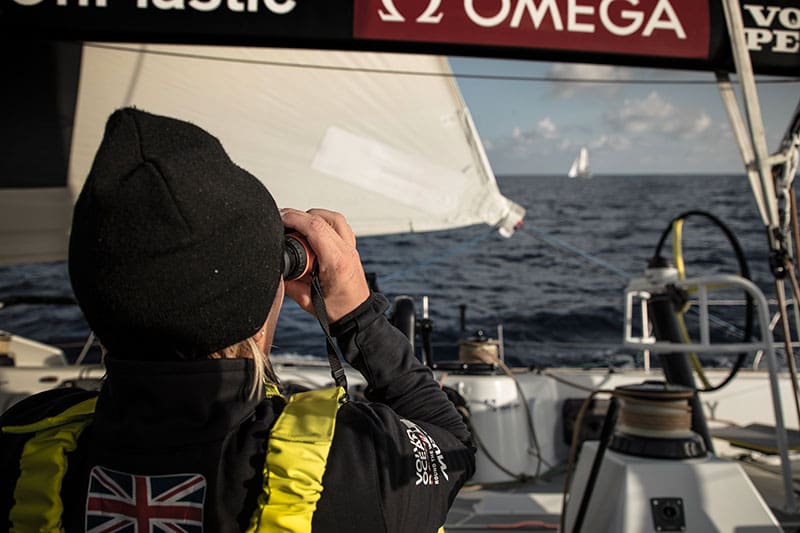
“It’s interesting for us to be in this group of four boats, trying to chase down the leaders. They’ve got a pretty good jump on us but we’re learning a lot by sailing so close to these boats for such a long period of time.”
Team Sun Hung Kai/Scallywag crew had more to worry about than where their rivals were – in the early hours of the morning skipper David Witt called everyone up on deck when there was an issue with the swivel pin at the top of their masthead Code Zero, sending the enormous headsail into the water.
It could have proved costly for the Hong Kong-flagged team but with all hands on deck they made light work of the recovery and were back to full speed in no time, with minimal impact on their position.
“We’re happy to be fighting in the pack of four boats, we’ve been sailing three miles away from each other for most of the past 48 hours now,” said Ben Piggott, in a written report from the boat.
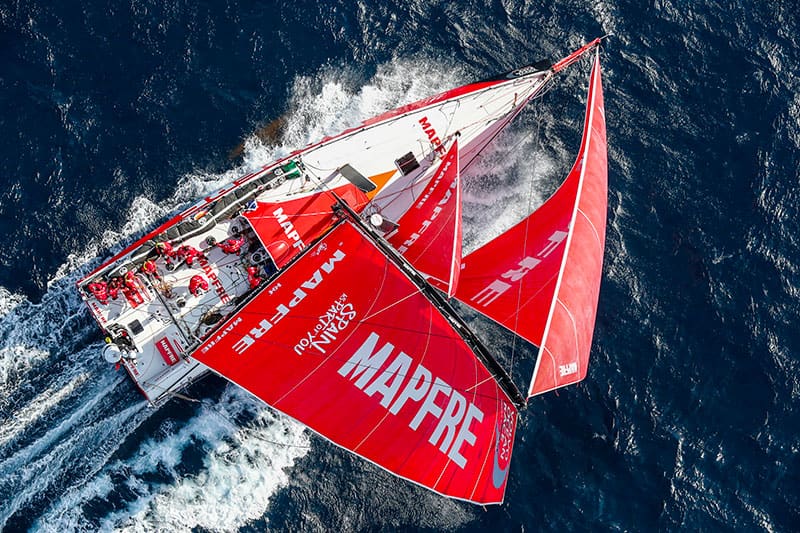
With 30 miles to make up on the leaders and fourth place to defend, the enormity of the challenge ahead was not lost on Dongfeng Race Team’s Stu Bannatyne, among the fleet’s most experienced sailors with seven previous Volvo Ocean Races to his name.
“We’ve got a lot of work to do yet,” he said. “It’s looking very difficult for us to get back into that lead group at the moment. We need to make sure we stay ahead of the group we’re in.”
The backmarkers will have an additional opportunity to make up ground as earlier on Wednesday, Race Director Phil Lawrence communicated a change in the racecourse for Leg 1 to the competitors.
A virtual mark, called ‘Porto Santo North’, approximately 220 miles due north of Port Santo Island, has been added as a mark of the course. Like Porto Santo, the teams will need to leave this mark to starboard, before turning east to head to Lisbon.
Leg 1 has a target time of seven days, and this additional waypoint adds approximately 200 miles to the racecourse pushing back the ETA for the leaders at the finish line in Lisbon to late Saturday morning.
Leg 1 – Position Report – Wed 25 October (Day 4) – 13:00 UTC
1. Vestas 11th Hour Racing — distance to finish – 850.9 nautical miles
2. MAPFRE + 6.3nm
3. team AkzoNobel +15.0
4. Dongfeng Race Team +27.4
5. Sun Hung Kai/Scallywag +28.2
6. Team Brunel +28.7
7. Turn the Tide on Plastic +29.4
8 October 2017
Vestas 11th Hour Racing win Leg 1 of the Volvo Ocean Race
Vestas 11th Hour Racing have won Leg 1 of the Volvo Ocean Race 2017-2018, crossing the finish line in the River Tagus in Lisbon, Portugal.
It’s a tremendous victory for American skipper Charlie Enright and his team, who earn 8 points for their efforts (including a one point ‘bonus’ for winning the leg).
It wasn’t easy. The wind shut down on the final approach, and an early morning lead of 34-nautical miles over second-placed MAPFRE was whittled down to 10-miles, with the finish in sight, but the current in the river even pushing the leaders back out to sea in some of the lulls.
But the crew on the Vestas boat held their nerve, tacking first up and then down, zigzagging towards the line, into agonizingly light headwinds.
“It’s incredible,” said Mark Towill, Team Director, from on board the boat moments before the finish. “What a way to kick off the event. it’s been an incredible performance for the team… It’s been a challenging leg. We still have a lot to improve and long way to go… Today is our day, we’ll enjoy it, but then we have to get back to work and focus on the next leg.“
Charlie Enright is the third American skipper to win Leg 1 of the Volvo Ocean Race. The others were John Kostecki, on illbruck in 2001-02, and Paul Cayard on EF Language in 1997-98.
Both of those teams went on to an overall victory – so the omens for Charlie Enright are certainly good.
Vestas 11th Hour Racing – which carries US and Danish flags – are the first American flagged team to win Leg 1. They are also the first Danish team to win a leg.
30 October 2017
Volvo Ocean Race: An epic Leg 1 in 230 seconds. VIDEO
A 1,450 nm sprint from Alicante to Lisbon, Leg 1 was the perfect start to the 2017-18 edition of the Volvo Ocean Race. Here’s what happened in a concise but rollercoaster 230 seconds!
1 November 2017
The life of a Volvo Ocean Race sailor in pictures: eat, sleep, sail, repeat
Leg 1 of the Volvo Ocean Race 2017-2018 saw the team’s race 1,850 nautical miles from Alicante to Lisbon, spending approximately 6 days at sea. Here are some of the best images that show just how weird life offshore can be…

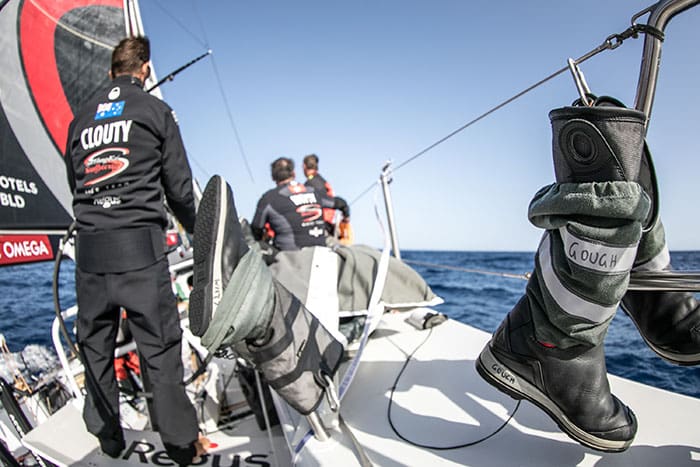
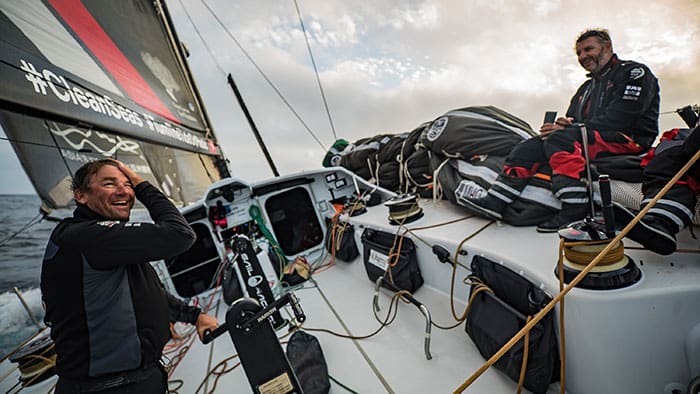
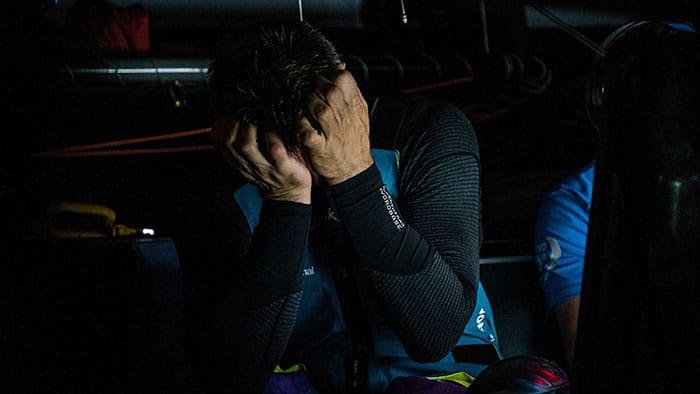
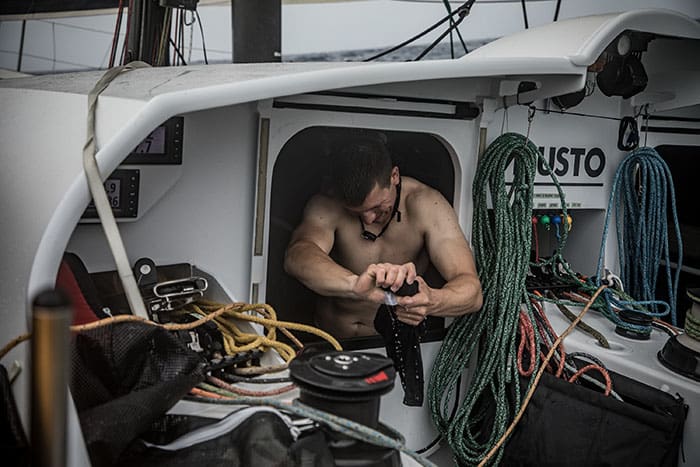
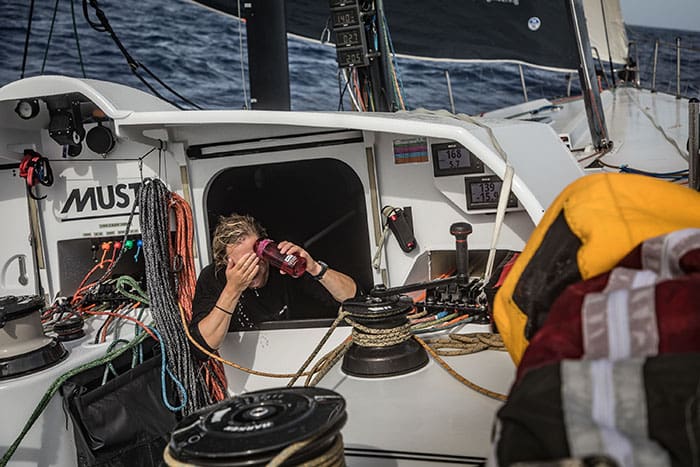
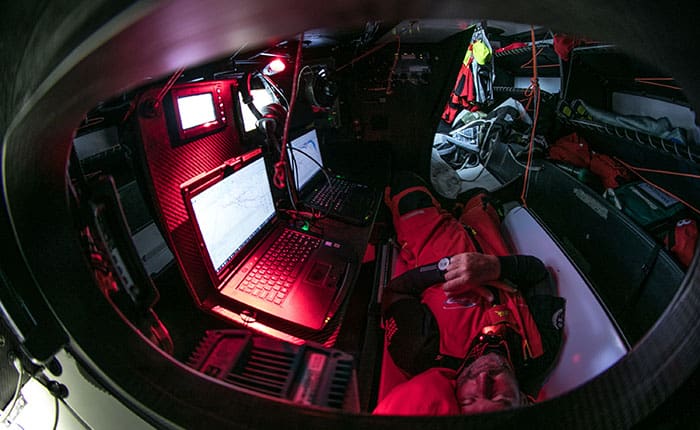
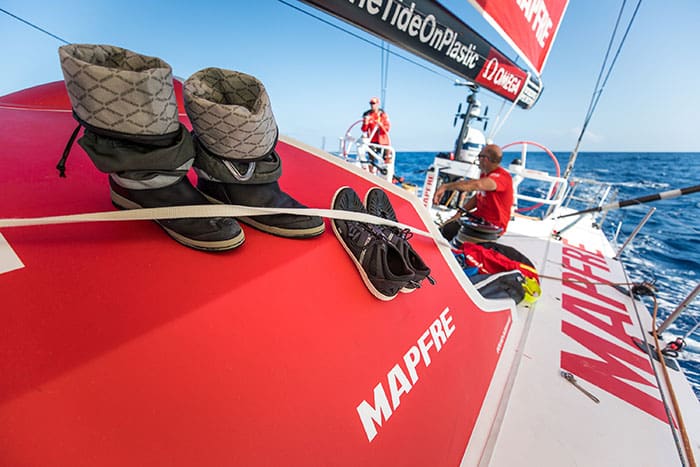
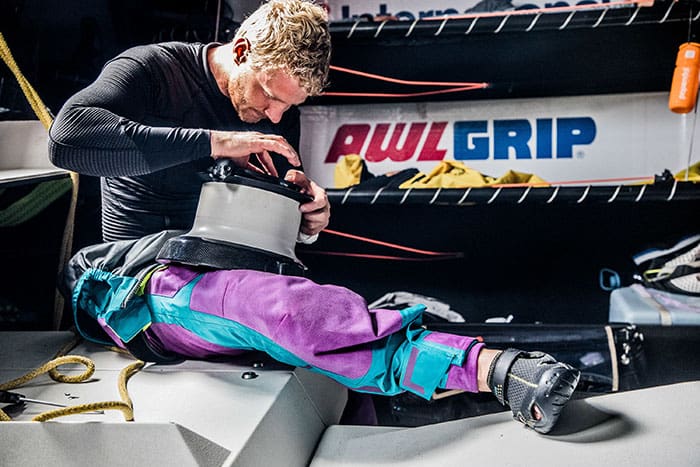
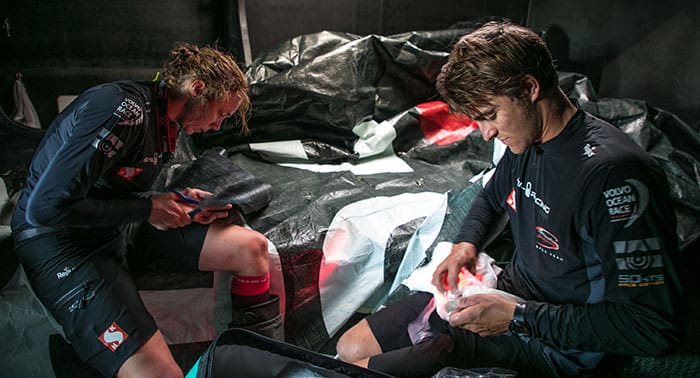
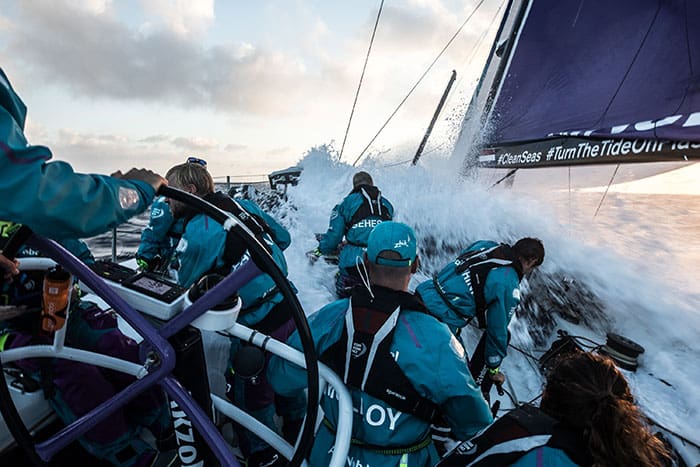
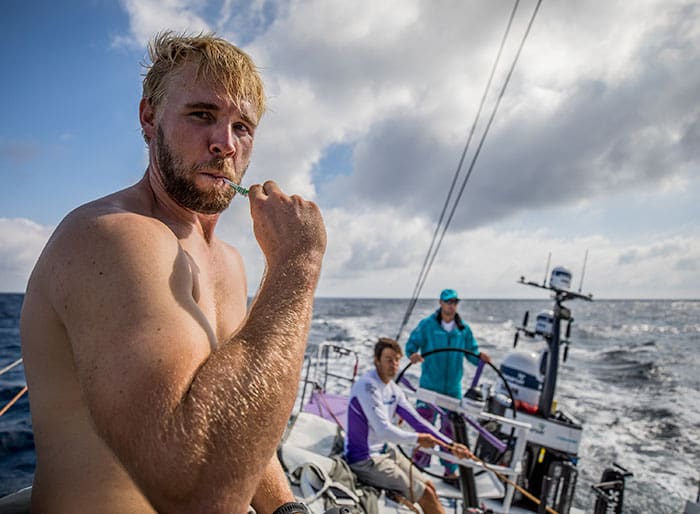

6 November 2017
Volvo Ocean Race: Fast and Frightening First Night at sea
Volvo Ocean Race Leg 2: it was an incredible start to witness, but the relentless winds and sea state made for a miserable life on board.
Sam Greenfield, the On Board Reporter on Turn the Tide on Plastic during this Volvo Ocean Race 2017-2018 described it well: “Sun is down now and we’re plowing through story high waves at speeds up to 30 knots. For this happy boat that’s redlining. The crew and the boat are holding up great. The OBR is … welll… It’s a game just to stay sat in the media desk chair without being thrown into the bulkhead that separates me and the nav station. Hell of a core workout. So much noise. So wet…“
“To be honest it’s really hard. In the 3 legs I sailed last race we never came close to these conditions. Saw some crazy things today. A wave threw Bianca off the stack and into the cockpit while she was clipped in. So much water that her pfd exploded. There she was trapped on her back in the cockpit, stuck by her tether taking hundreds of gallons of water to the face. It was scary to watch. Liz got to her quickly and sorted her out.“
Fortunately, the fleet appears to have come through the first night well, and conditions are moderating somewhat.
Wind speed is in the 20-25 knot range and boat speeds just over 20 knots.
MAPFRE and Dongfeng Race Team have pride of place on the leaderboard this morning, but the rankings can be somewhat misleading.
The goal for these first days is to choose the right place to cross the upcoming doldrums. Historically, the further west, the quicker the passage. But the leaderboard rewards southerly progress.
So MAPFRE, first to gybe, and furthest south, is our nominal leader this morning. but it’s entirely possible that Vestas 11th Hour Racing, furthest west, is in a tactically stronger position.
It will take a few more days to sort it out, but in the meantime, take the tracker rankings with a grain a salt.
11 November 2017
Week in review – Leg 2, Week 1 | Volvo Ocean Race
Incredible scenes at the start of the second leg in Lisbon, followed by day after day of fast downwind racing – the first few days of Leg 2 was unmissable. Here’s a look back at the action.
24 November 2017
MAPFRE win epic Leg 2 of the Volvo Ocean Race
The Spanish flagged MAPFRE team has won Leg 2 of the Volvo Ocean Race, a 7,000 nautical mile marathon from Lisbon, Portugal to Cape Town, South Africa.
“It’s amazing, we’re super-happy. We came here in one piece and in front of the others, we can’t ask for more,” skipper Xabi Fernández said moments after finishing.
“This is what we will see all the way around the world. Super-tight racing, everyone has good speed and small mistakes are very expensive. This time we were luck to do the least mistakes and that’s why we won.“
For most of the first half of the leg, MAPFRE trailed Dongfeng Race Team on the long charge to the south, but last weekend, after crossing the Doldrums, 14 days into the leg, navigator Juan Vila and skipper Xabi Fernández made the winning move, a quick gybe to the southwest that Dongfeng didn’t cover.
Within hours, the decision paid and MAPFRE had a tactical advantage they would never relinquish over the final week of racing.
The team earns 8 points for the Leg 2 victory (7 points plus one bonus point for the win), which is enough to take the overall lead in the race regardless of the finishing positions behind.
For Leg 2, MAPFRE sailed 7,886.5 nautical miles over the ground at an average speed of 17.3 knots.
2 December 2017
Volvo Ocean Race: Leg 2 in 200 seconds. VIDEO
What an incredible leg from Lisbon to Cape Town! The three-week race had everything – fast, wet sailing, a Doldrums crossing, an Equator ceremony, and extremely close racing! Here’s all the action in 200 seconds.
10 December 2017
Volvo Ocean Race fleet flying out of Cape Town
Charles Caudrelier’s Dongfeng Race Team and the Spanish MAPFRE squad were neck and neck leading the Volvo Ocean Race fleet out of Cape Town and towards the southernmost point of the African continent on Sunday.
It was the eleventh time in the history of the event that the fleet had raced out of Cape Town, this time on a 6,500 nautical mile leg to Melbourne, Australia. The ETA is currently between the 24th and 26th of December.
Conditions were ideal, with the famed Cape Doctor wind blowing at 20-25 knots. The fleet raced around a short triangle course in front of the city, before being freed to sprint off towards Australia.
There was some drama for the Dongfeng team who had to make a late crew change just before leaving the dock. Daryl Wislang suffered a back strain this morning and the team decided not to risk having it flare up more while at sea. He stepped off the boat to be replaced by Fabien Delahaye.
The forecast is for very strong winds on Sunday evening and overnight, which should then ease for a brief respite, before strengthening again as the first of the Southern Ocean weather systems that will pick them up and carry them to Melbourne comes calling.
“It is the worst sailing you can do but it’s also the absolute best,” said Stu Bannatyne, a three-time race winner on board Dongfeng, in reply to a question about the Southern Ocean.
“Fortunately it seems the human mind forgets the bad times and only remembers the good, which is why we keep coming back.”
That is a sentiment that is sure to be shared among the 63 sailors (and seven on board reporters) over the coming days.
18 December 2017
Close action in the Southern Ocean as Dongfeng and MAPFRE continue their match race
Current Leg 3 frontrunners Dongfeng Race Team and MAPFRE have been racing practically neck and neck on Monday as the Southern Ocean continued to test the Volvo Ocean Race fleet.
After eight extraordinary days at sea less than three nautical miles split leg leaders Dongfeng from arch-rivals MAPFRE in the runner-up spot, with both crews within 2,700 miles of the finish line in Melbourne, Australia.
The action at the front has been so tight that earlier today MAPFRE had to ease their sails in order to avoid a collision with leaders Dongfeng on one of many close crosses over the past 12 hours.
It is an incredible occurrence given their position thousands of miles from anywhere. In fact, in the past 24 hours the fleet has sailed a few hundred miles north of the Kerguelen island chain, one of the most isolated places on the planet.
Overnight MAPFRE slipped to almost 20 miles adrift of Dongfeng, but when the sun came up again Xabi Fernandez’s Spanish crew were back on the coat tails of Charles Caudrelier’s Franco-Chinese outfit.
“Not too long ago we had a port-starboard situation with MAPFRE, and that’s an amazing thing to have happen,” Dongfeng’s Carolijn Brouwer reported. “The guys on MAPFRE had to ease their masthead sail and arc up to avoid hitting us. We’ve been battling it out, gybing the whole night through, with probably an hour max on each gybe. It’s been pretty tiring”.
“For us it’s a bit frustrating that they’re so close, because we had a lead on them but they sailed a bit better and caught up. That said, it’s amazing to be out here in the middle of nowhere with your opposition right next to you. It’s a bit surreal but it makes us push the boats harder“.
MAPFRE’s sailors meanwhile have been buoyed by their ability to bounce back and reel in Dongfeng. Navigator Juan Vila revealed that, for now, they are happy to stay in touch and wait for the opportune moment to strike.
“I have Dongfeng on the AIS every now and then,” Vila said. “We gain on them sometimes but it’s back and forth. There are plenty of opportunities left to do something different. Hopefully we will find our lane and it will work out for us.”
Fourth-placed Team Brunel were dealt a cruel blow with key crewmember Annie Lush suffering an injury to her back.
Lush and teammate Peter Burling were grinding on the aft pedestal as Team Brunel prepared to gybe close to the Antarctic Ice Exclusion Zone when a huge wave swept them into the guard rail at the back of the boat.
Burling was unhurt but Lush was left with pain down her right side and struggling to move her right leg.
The crew responded immediately, carrying her down below and into her bunk where she has remained since.
The British sailor, 37, has been prescribed painkillers and plenty of rest by on-call race doctor Spike Briggs. While she recovers, the rest of the crew must push on shorthanded, making their task ahead even more challenging.
“Even though the ice gate was coming up it didn’t matter – we would have got a penalty but safety comes first,” Bekking said. “Annie will be confined to her bunk another 24 hours and hopefully she’ll be ok. She’s a tough cookie.”
Just over 220 miles behind the leaders, team Akzonobel were working hard to get back into the game after a broken mast track last week relegated them to the back of the pack.
Now back up to full speed, navigator Jules Salter was today spending his 49th birthday poring over long range weather forecasts as the crew rides a front east.
“What we get now from this system we may pay for later,” he said. “With still such a long distance to run to Melbourne and the fact looking at the models for just a week ahead is more like crystal ball gazing we have to hope that something will change.”
25 December 2017
MAPFRE first into Melbourne to earn consecutive leg wins
The Spanish Volvo Ocean Race team MAPFRE has won Leg 3 from Cape Town, South Africa to Melbourne, Australia, a 6,500 nautical mile dive into the fierce challenges posed by the Southern Ocean.
For the second consecutive leg, MAPFRE needed to come from behind to earn the victory. And for the second time in a row, it was Dongfeng Race Team they passed mid-stage, to snatch the win.
“We had to fight very hard for this victory,” skipper Xabi Fernández said moments after crossing the finish line. “There’s so much of the race to go. But for now it’s looking good and we’re very happy of course.”
The Southern Ocean pushed the teams to the limit. Extreme cold, storm force winds for days on end and towering seas posed massive seamanship challenges, let alone allowing for racing and tactics.
But of all the teams on Leg 3, MAPFRE had the highest work rate in terms of manoeuvres, which allowed them to stay in more favourable conditions for longer than their opposition. It was a powerful statement by a very strong crew.
“The strongest point for this team is the group of people we have,” Fernandez acknowledged. “They are so good and give us so much and have been working so hard on this leg. It was so tough, but it’s all gone perfect. Now we have a few days for recovery and we can get ready for the next one.”
MAPFRE started Leg 3 already atop the leaderboard, with a one point lead over Leg 1 winner Vestas 11th Hour Racing. But as this first Southern Ocean challenge is worth double points, the team will now open up a more comfortable margin – at least six points – depending on the finishing position of the chasing boats.
9 January 2018
Volvo Ocean Race Leg 4. Hard, hot, and slow work in the Doldrums
It’s slow going as the fleet bumps up against calm conditions in the doldrums during Volvo Ocean Race 2017-2018 Leg 4…
As Volvo Ocean Race Leg 4 neared its halfway point on Tuesday, any memories of the freezing cold Southern Ocean had long been banished.
With every mile that the fleet climbs further north through the South Pacific, so the temperature of both the air and water rise too.
Gone are the days of wearing countless layers of weather-proof clothing in a desperate attempt to stay warm and dry.
Instead, seven days into the 6,000 mile leg from Melbourne to Hong Kong, the Volvo Ocean Race sailors are battling extreme heat as they close in on the Equator.
The lack of breeze in the Doldrums only compounds the problem, slowing their progress through one of the most notorious climate zones for sailors.
Usually lighter airs give sailors a chance to rest ahead of the next big blow but there’s no respite from the heat – it’s hotter down below than it is on deck.
“It’s probably a really nice, comfortable 50 degrees celsius downstairs and about 47.8 degrees up on deck,” said Vestas 11th Hour Racing’s Phil Harmer with a wry smile. “The sea temperature is 32 degrees – it’s just a pleasure. Even the off-watch guys don’t want to be down below.”
Team Sun Hung Kai/Scallywag’s Ben Piggott, the youngest sailor in the fleet at just 21 years old, added: “It’s refreshing being able to sit up on deck and not wear five layers of clothes but at the same time it’s so frustrating because we’re just not going anywhere.”
The blistering speeds of the opening few days of the leg might too be a distant memory but the racing continues to heat up.
At 1300 UTC Dee Caffari’s Turn the Tide on Plastic topped the Leg 4 leaderboard as the most westerly boat in the fleet, with the Vestas squad, team AkzoNobel, Dongfeng Race Team and MAPFRE all lined up alongside them across a 15-mile gap.
It’s so close at the front that most boats are in sight of one another after 3,000 miles of intense ocean racing.
Team Brunel were just 11 miles directly behind Turn the Tide, while Scallywag was some 30 miles back.
Although Hong Kong lies some 3,000 miles to the north west of the fleet, the short-term goal is to get north as quickly as possible to reach the trade winds.
Once into this stable breeze the teams will be able to swing their bows left, open up the throttles and start knocking off the miles to the Volvo Ocean Race Leg 4 finish. But this respite is still some 36 hours away.
19 January 2018
They did it… Sun Hung Kai/Scallywag has won Leg 4 of the Volvo Ocean Race!
Team Sun Hung Kai/Scallywag have won Leg 4 of the Volvo Ocean Race, from Melbourne, Australia to their home port of Hong Kong.
It’s an historic win for skipper David Witt and his team who had to overcome significant setbacks on the leg before grabbing the lead with a bold tactical call out of the Doldrums last weekend.
“We had a bit of a plan and we stuck to it. Sometimes it works, sometimes it doesn’t and this time it worked for us,” Witt said.
It was an extended Doldrums crossing, and Sun Hung Kai/Scallywag had moments where they appeared to be in a strong position.
But late in the crossing, after falling behind the fleet again, Witt and navigator Libby Greenhalgh made the decision to cut the corner, and turn to the west earlier than the opposition who kept pressing north in search of stronger winds.
The move paid dividends nearly immediately on the leaderboard as Scallywag had less miles to sail to the finish line, but pundits cautioned that the teams in the north would almost certainly overhaul them as the tradewinds filled in from the northeast.
It never happened.
Even when the team dropped miles recovering a man overboard after Alex Gough was swept off the boat by a wave, after executing a flawless recovery, Scallywag returned to racing and extended to nearly a 100-mile lead.
But then, the chasing boats began chipping away at the lead. Two days out from the finish, the margin had been cut significantly and the pressure mounted.
“I was really impressed by the way we operated over the past couple of days,” Witt said. “We had a pretty big lead and then through no fault of our own, about two-thirds of it got taken away. But we stuck to our guns, did what we thought was right and it’s worked out.”
With the Leg 4 win, Sun Hung Kai/Scallywag picks up 8 points (7 points for first place plus a one point win bonus). It will vault the team up to mid-fleet on the overall leaderboard, in a very respectable fourth place.
“It was always going to take us longer than the others to get up to speed as we were the last to enter,” Witt said. “All teams need a bit of confidence and I think one thing that is underrated in sport is momentum and this will certainly give the Scallywags plenty of that… We’re all still learning and we’re going to keep getting better as we go on.”
Witt has acknowledged the significance of the win as the local team leading the fleet into the first ever Volvo Ocean Race stopover in Hong Kong. For the team owner, Seng Huang Lee, who has supported Sun Hung Kai/Scallywag sailing over the years, it’s a big moment.
“We’re a privately owned team and our owner Mr. Lee has poured his passion and enthusiasm and vision into this project and this win will be very special for him… Winning this leg will be a massive platform for Scallywag going forward.”
27 January 2018
Team AkzoNobel wins the HGC In-Port Race Hong Kong
Team AkzoNobel took the win in the HGC In-Port Race Hong Kong on a challenging afternoon on the waters of Kowloon Bay.
The wind during race time was a 6 to 10 knot Easterly, but it was very shifty and puffy, and with a tidal current running on the race course, it was a difficult day for the tacticians.
“We had a fantastic race, pretty exciting. We planned to sail our own race today. It was tricky enough with the tide and the windshifts,” said team AkzoNobel skipper Simeon Tienpont.
“The team sailed an unbelievable race and the guys in the back of the boat played the tactics very well… It’s good when things come together. It’s a nice reward for all the effort the team has put in.”
Dongfeng Race Team finished in second place, with Team Brunel third. The two swapped places on the third lap of the course after a solid upwind leg by Brunel gave them the lead, but the Dongfeng crew fought back on the run to secure second place.
A fourth place finish on Saturday by the series leader MAPFRE means Dongfeng vaults to the top of the table.
But it’s a tight leaderboard and it could compress further following Sunday’s Around Hong Kong Island Race, when results of the weekend of racing will be combined to assign the points from this stopover.
Hong Kong’s hometown heroes Sun Hung Kai/Scallywag had a fantastic start, but fell back and battled to a fifth place finish over Turn the Tide on Plastic on Saturday. Both teams will be determined to move up with a better result on Sunday.
The Around Hong Kong Island Race is scheduled to start at 11:30am local time in Hong Kong (0330 UTC).
6 February 2018
Volvo Ocean Race, Ready for Leg 6? Target: Auckland
Volvo Ocean Race Leg 6 is a 6,100 nautical mile race to Auckland, New Zealand. The fleet will start by crossing the South China Sea to the northern tip of the Philippines. After that, it’s out into the Pacific and a long drag race to the south-east, dodging the many island chains of Polynesia until they reach Auckland.
It’s another leg that will be dominated strategically by the north to south transit of the Doldrums, which proved so decisive on Leg 4 into Hong Kong. And of course, the final run in to Auckland, down the east coast of New Zealand has seen many classic match races over the years, as the fleet finishes in the City of Sails.
MAPFRE, the overall race leader, will cross the start line to Auckland with a four-point lead over Dongfeng Race Team. With another Doldrums crossing looming, both skippers see the potential jeopardy in the leg.
“The leg to Auckland is what I call a tricky leg,” said Dongfeng skipper Charles Caudrelier. “We have to cross the Doldrums and we know it’s complicated and a bit random and we’re concerned about being the guys who catch a bad cloud this time”.
“But it’s also one of the best legs as you arrive in Auckland which is a fantastic place where people really know offshore racing and love the race.”
Spanish skipper Xabi Fernández knows first-hand the challenge the Doldrums pose, as on Leg 4, a solid start to the stage turned into a losing battle with clouds and a disappointing result.
“We all know how hard the Doldrums can be and last time, for us it was even harder,” Fernández said. “We found ourselves a little bit separated from the leaders and for 10 or 15 hours it was painful as we watched the others sail away…”
The forecast for start time at 1100 on Wednesday morning in Hong Kong is for a 12-15 Northeasterly wind, ideal conditions to get the fleet on their way to Auckland. But as the fleet gets into the leg, stronger winds are forecast over the first days.
“It’s always notorious this bit,” said Turn the Tide on Plastic skipper Dee Caffari. “I remember from the last edition when we left Sanya (China) we had similar upwind, strong conditions through the Luzon Strait. So it’s the same again this time.”
“It’s also a bit deceiving as we almost sail away from New Zealand before we put the bow down and make that commitment and head down there. So psychologically it’s a hard leg as well.”
This will mark the 11th time the race has visited New Zealand and the 10th time it has stopped in Auckland. Many will look at New Zealand as a spiritual home to the Volvo Ocean Race, with over 350 Kiwi sailors having taken part in the race dating back to 1977.
12 February 2018
The Volvo Ocean Race Leg 6? Fast, Wet and… Wild!
Conditions are fast, wet and wild, during Volvo Ocean Race Leg 6, for the fleet on Sunday as they charge to the southeast, finally heading in a direction where miles sailed translate into miles towards the finish in New Zealand, still more than 4,000 nautical miles away.
With the passage of a front, the wind has shifted to the north and the boats are on a tight reach in 18 to 25 knots of wind, making 20 to 25 knots of boatspeed. It’s not comfortable. But it’s fast.
“Since the front hit it’s been pretty full on,” said Blair Tuke from on board MAPFRE. “To start with it was about as good sailing as you can get, 20 to 25 knots of breeze and flat, flat water. But over the last few hours, things have just got gradually a little bit worse. Sea state and water on deck, it’s probably the most water I’ve ever seen.”
“This is a great way to gain some miles after some slow upwind sailing that we have been doing,” agreed Dee Caffari from Turn the Tide on Plastic.
“There is water pouring down the deck, everyone is wet, everything is wet inside and out but no one is complaining as we all know this is short lived and we will cover some serious miles while we are at it. And the water is warm, 19 degrees, matching the air temperature.”
The fleet is still largely in two groups during this Volvo Ocean Race Leg 6, with MAPFRE holding the narrowest of leads over Team Brunel and Dongfeng Race Team, and Turn the Tide on Plastic is just 13 miles behind.
The second group had consisted of team AkzoNobel and Scallywag, but their paths are beginning to diverge, with Scallywag charting a southern route and cutting the corner. It was a strategy that worked on Leg 4… we’ll see over the coming hours if it is successful again.
20 February 2018
Volvo Ocean Race: No pain, no gain, as Doldrums take their toll
The Volvo Ocean Race fleet is facing another 48 hours of excruciating sailing as the teams plugged deeper into a massive expanse of windless ocean on Tuesday.
Lying ahead of them is a 400-mile gulf that stretches as far south as New Caledonia, severely hampering progress towards New Zealand as Leg 6 enters its 14th day.
And with the finish line in Auckland still more than 1,500 miles away, a glance at the forecast provides little relief with no sign of breeze materialising in the short term.
As well as battling the elements, the fights on the water have become personal, with the six-strong fleet splitting into pairs, essentially forming three mid-ocean match races.
Team Sun Hung Kai/Scallywag and team AkzoNobel continue to lead the way south, with Turn the Tide on Plastic and Team Brunel neck and neck around 50 miles to the north-east, but only 20 miles behind on distance to finish. This leverage to the east could prove decisive over the coming days.
Fifty miles further south, and 75-miles behind the leaders, MAPFRE and Dongfeng Race Team continue their hunt for a way back into the leg, split by less than a mile.
While full-on storm conditions are physically exhausting, a lack of breeze pushes the sailors to the limit of mental tiredness as they search desperately for a route that might provide the tiniest speed advantage over their rivals.
“It’s tricky… snakes and ladders,” said David Witt, skipper of Team Sun Hung Kai/Scallywag, after they overhauled AkzoNobel to take the top spot. “There’s two more days of this, so there’s not much sleep coming up.”
The cause of the giant wind hole is a huge storm – Gita – currently battering the south island of New Zealand that has killed the trade winds, allowing the Doldrums to swell to epic proportions.
All the teams can do is take their best guess at the quickest route south, make the most of whatever local weather comes their way, and keep their fingers crossed that the forecasts are wrong.
The uncertainty and frustration is shared throughout the fleet.
“It feels like we are in three match races, we’re just are not sure who is playing the finals, who is playing the semi-finals and who is playing for the wooden spoon,” a bemused Turn the Tide on Plastic skipper Dee Caffari said.
Bouwe Bekking, skipper of nearby Team Brunel, added: “Sometimes we think we have the greatest sport there is, but on days like these I think the majority of the crew think that it can be a stupid sport as well.”
The one bonus is that the teams are not alone in their struggle. The windless zone is so huge that it has ensnared all six teams, and what affects one affects them all.
“Since the start we’ve been together with Dongfeng, and today’s just another day that we’re within a mile of each other,” MAPFRE skipper Xabi Fernández said.
“We had a few clouds this morning and lost about four miles but now we’re back with them. It’s very hard to overtake them and it’s hard for them to overtake us. At least we’re very well entertained by each other.”
The key to escape will be picking up the new breeze first. But which pair will find salvation first remains to be seen.
27 February 2018
Team AkzoNobel has won Leg 6 of the Volvo Ocean Race!
Team AkzoNobel has won Leg 6 of the Volvo Ocean Race, racing 6,344 miles from Hong Kong to Auckland in 20 days, 9 hours and 17 minutes and 26 seconds.
It was a tremendous win, and came after an epic final 24 hours, when a ridge of high pressure off the north east coast of New Zealand stalled the progress of the leading boats, allowing those behind to close what had appeared to be an insurmountable gap.
For team AkzoNobel and SHK/Scallywag, the buffer they’d built up over the past week was only just sufficient, and they were able to match race down the coast all the way to the finish line in the Waitematā Harbour, usually sailing within hailing distance of each other.
In the end, the margin at the finish was just two minutes between first and second place.
“It’s been a 6,500 mile match race, it’s unreal,” said Tienpont. “I’ve never sailed a race like this in my life. We’ve always been in each other’s sights. They were always there. It’s been neck and neck. Huge respect to Scallywag, they never stopped fighting and we never stopped defending. I’m so proud of our crew. They never flinched.”
It’s the first leg win for team AkzoNobel and earns the team an important 8 points on the leaderboard, after fighting all the way to the finish with Scallywag.
“Our team never gives up,” said Scallywag skipper David Witt. “We just didn’t pull it off this time. We had our chances, but AkzoNobel were just a little bit too good this time. But we’ve come a long way since leg one.”
The second place finish in Leg 6, combined with a leg win into their home port of Hong Kong, has elevated SHK/Scallywag up to third place on the overall leaderboard.
While the weather pattern of the last 24 hours has made for a heart-stopping finish for race fans, it also led to a heart-breaking result for Dee Caffari’s Turn the Tide on Plastic.
Just 24 hours ago, Caffari and her team appeared poised to claim their first podium of the race, even while challenging for the leg win. MAPFRE and Dongfeng Race Team, first and second on the overall leaderboard, were over 60 miles behind Caffari.
It would have made for a well-earned and popular result for an underdog team. But as the leading trio bumped up against an unavoidable patch of calm winds, MAPFRE and Dongfeng roared in, closing the gap down minute by minute.
As darkness fell on Tuesday night and the wind picked up for the final 60-mile sprint to the finish, the two powerhouse red boats were within striking distance of Caffari and her team, just 2 miles back. And over the next 90 minutes, they were able to grind their way past, pushing Turn the Tide on Plastic back into fifth place with 20 miles to run.
While Caffari and her crew showed incredible fighting spirit, clawing ahead of Dongfeng Race Team once again as the boats raced through the Hauraki Gulf on the final approach, they couldn’t hold on, and would need to settle for fifth place, behind both MAPFRE in third and Dongfeng in fourth.
“It’s been a crazy 20 or 21 days, match racing all the way here,” said MAPFRE skipper Xabi Fernández. “We’ve been fighting with Dongfeng like crazy. We never stopped, we fought so hard, and now we feel very happy of course. We were hoping for opportiunites in the doldrums and they never came, but finally they came today, and we did it.”
“We’re sorry for Turn the Tide on Plastic,” said Dongfeng skipper Charles Caudrelier. “They did a fantastic race and I think they deserved a third place finish, but that’s sailing, they’ve been unlucky today and we managed to come back… It was a good surprise.”
Overlooking the immediate disappointment of the day, this marks the best result of the race to date for Turn the Tide on Plastic and is a sign of progress for a young and improving team.
16 March 2018
Volvo Ocean Race Leg 7: ready for the Iconic Southern Ocean challenge?
Volvo Ocean Race 2017-2018 Leg 7 is an iconic Southern Ocean challenge; a 7,600 nautical mile race through “Furious Fifties”, the inhospitable, remote waters south of 50-degrees latitude that circle Antarctica, around Cape Horn and up to Itajaí, Brazil.
“It’s going to be bloody cold,” said Bouwe Bekking, the skipper of Team Brunel, who is on his eighth lap of the planet. “It’s probably the best sailing you can get. We know the boats so well at this point in the race, we will be pushing 100 percent“.
“And going around Cape Horn is a big psychological boost as you know the Southern Ocean is behind you, every mile you go north it gets warmer. So it’s a funny thing, there will be moments when you hate it, but you know better times are ahead and when you arrive in Brazil, you forget the bad parts and the good parts stay with you.”
Volvo Ocean Race Leg 7 is a double-point scoring leg, with an additional bonus point awarded to the first boat to pass Cape Horn. With so many points on offer, this classic Southern Ocean leg, a return to the roots of the race, has the potential to be decisive on the leaderboard.
MAPFRE is the overall leader following six legs, but after a fourth place finish and late charge to get on the podium on the leg into Auckland, the team’s position at the top doesn’t appear as secure as it was early on.
“Of course I feel like they are coming closer and faster, but we can only do one thing – push the boat, sail well and try to win this leg,” said MAPFRE skipper Xabi Fernández, who has six previous roundings of Cape Horn to his credit.
“If we can win this leg, it’s a big step forward. There is nothing to change, we just need to sail a little bit better than the others and push a little bit harder.”
Scallywag is one of the teams putting pressure on the leaders. The team is coming off one-two finishes on the last two legs, vaulting up the leaderboard to third place. Skipper David Witt was succinct when asked about his approach to this Southern Ocean leg.
“We’re going to win the leg or drop the rig. That’s the mentality,” Witt said. “This is a big chance for Scallywag to stay up there and do something or drop back towards the back of the pack… We don’t care what goes wrong or what breaks… We’re just going to send it.”
Another team making a push up the leaderboard is team AkzoNobel. Skipper Simeon Tienpont led his team to victory on the race into Auckland, and now he’s determined to continue the charge.
“You always have to look at the race as a whole and there’s more than 50 per cent to go in terms of points. It’s been a big improvement and a big learning curve. We’re working unbelievably hard and we want to keep the momentum going. The leg win into Auckland proved we’re on the right track and gives some confidence.”
The Ice Exclusion Zone for Volvo Ocean Race Leg 7 is set very far south, at points diving as deep as the 59-degree south latitude line. In theory this will shorten the distance the boats need to sail, and speed up the leg. But it comes at a cost – more bitter cold and towering seas, in wind and waves that circle the planet unimpeded. The challenge isn’t lost on the sailors.
“You can’t ignore where you’re going and the responsibility that lies with the skipper,” said Dee Caffari, the skipper of Turn the Tide on Plastic. “But we have already had Leg 3, from Cape Town to Melbourne. Everybody has had a taste of how wet, cold and windy it can be. We’re not going down into the unknown, which gives you a lot more confidence.”
Dongfeng skipper Charles Caudrelier can speak first-hand about how challenging this part of the world can be.
“It’s a difficult leg for sure. Sometimes you have to forget the race and take care of the boat and the crew,” he said. “I know this very well. I’ve done this leg twice and never finished with the mast up! And Pascal (Bidégorry) did this leg twice and he’s never made it past Cape Horn!! So that is one of our goals, make it past Cape Horn and finish with the mast up!”
Re-joining the fleet is Vestas 11th Hour Racing after missing the last two legs with damage sustained in a collision near the end of Leg 4. Skipper Charlie Enright says his team is eager to get racing again and resume challenging the leaders.
“The team has come together great, the repair has come together great,” he said. “There are 16 points available to the winner and to put that into context, we have 23 points now, so it’s going to be a big move and shake. We had a successful Southern Ocean leg last time and we’re looking to repeat that performance.”
Volvo Ocean Race Leg 7 will start at 14:00 local time in Auckland, 01:00 UTC on Sunday, 18 March.
21 March 2018
Volvo Ocean Race Leg 7: Cape Horn We’re Coming!
Four days into the Volvo Ocean Race Leg 7, the teams have reached the Furious Fifties and made their turn to the east, pointing towards the famed Cape Horn…
Vestas 11th Hour Racing posted the first 500-mile run of Leg 7 on Wednesday as the fleet charges towards the ice exclusion zone.
Four days into the 7,600-mile leg from Auckland, New Zealand, to Itajaí, Brazil, there has been little let-up for the seven teams as they continue to push ever deeper into the Southern Ocean.
A north-easterly wind of 20 and 30 knots has guaranteed rapid sailing conditions and similar boat speeds from the Volvo 65s.
Vestas 11th Hour Racing clocked off 500.2 nautical miles in the 24 hours leading up to the 0700 position report, with their six rivals all within 15 miles of the target.
Until now the race has been to get due south as fast as possible to skirt round the bottom of a big anticyclone, but today the teams – split on the water by 25 miles – started to swing round to the east as the ice exclusion zone quickly approaches.
The shortest, and therefore technically the quickest, route will see the fleet bounce along the exclusion zone, put in place by race management to keep the teams away from Antarctica’s icebergs.
At 1300 UTC Vestas 11th Hour Racing had slipped to second place, having surrender the top spot to team AkzoNobel as the fleet blasts east.
“It’s still pretty tight – we’ve got Dongfeng and MAPFRE coming at us pretty quickly at the moment, and we can see Brunel’s light up to windward,” Akzonobel’s navigator Jules Salter explained.
“Everyone’s doing 22, 23 knots so we’re really only 10 or 15 minutes apart from each other. The sea state and the wind is changing all the time, and we’re just trying to find the right combination for the sails. The guys on deck have a lot of work on.”
The next challenge facing the teams comes in the shape of a monster depression brewing to the south containing winds in excess of 40 knots.
“There’s definitely some more wind coming, that’s for sure,” Salter added. “We’ll also have to start doing a few gybes and that’s going to be pretty tricky in those big winds and waves. The hardest bit is yet to come.”
The impending storm is also at the forefront of Dongfeng Race Team skipper Charles Caudrelier’s mind as he spurs on his fifth-placed team.
“There will be five tough days to go until we reach Cape Horn,” Caudrelier said. “Five days is long in these conditions when you are close to the ice limit, in the coldest area, with many manoeuvres – it really is going to be very hard”.
“We will really have to look after the boat and the sailors because there will be a lot of rough sea, a lot of wind and a lot of rotations. This is the worst because manoeuvres in these conditions and in the big seas are difficult, but we have no choice. This is it – the Great South.”
As well as living with the constant damp and plummeting sea and air temperature, Bouwe Bekking’s fourth-placed Team Brunel has had other issues to contend with.
“It just feels like there’s always something to do,” Abby Ehler explained. “We had a couple of breakages on the first day, we’ve got a little tear in the J2 and our AIS isn’t working, which is a real hindrance not being able to see the rest of the fleet. We’re working our way through all these mishaps.”
Each team will be working to get their equipment in the best shape possible before the big breeze forecast for the coming days.
29 March 2018
Team Brunel leads fleet past Cape Horn and out of the Southern Ocean
Skipper Bouwe Bekking and navigator Andrew Cape have used their veteran nous to sail Team Brunel past Cape Horn at the head of the Volvo Ocean Race 2017-2018 fleet.
Bekking and his team passed the famed Cape at 13:01 UTC (provisional) on Thursday and earn one point on the leaderboard for being first past the Horn.
But even with a successful passage from the Pacific into the Atlantic Ocean, Bekking said the mood on board during the approach to Cape Horn was subdued.
“The crew is very, very, very tired,” he wrote earlier on Thursday. “Even though we are leading, there is no ‘hurray’ feeling on board… The loss of John is sitting way deeper than people like to admit: I think of him several times in an hour.”
He’s not alone. As the sailors have some more time to digest the news about the loss of Scallywag’s John Fisher, the impact is sinking in.
“This leg has claimed a good man in Fish,” said team AkzoNobel’s Chris Nicholson. “We’ve all been very deeply affected by it and we offer our thoughts to his family and friends.”
Chasing Team Brunel to Cape Horn is a group of five boats led by Vestas 11th Hour Racing.
“I can speak for everyone on board to say we’re all really, really looking forward to getting there,” said navigator Simon Fisher.
“It’s the hardest of the great Capes to take on and this has probably been the toughest Southern Ocean leg on record for quite some time. I’m on my fifth race now and I don’t remember one as hard. As usual it’s blowing about 35-40 knots, so really, there’s just been no let up in the last week and half to these conditions…”
“We’re certainly taking stock to think about what it means to get around Cape Horn and also to pause and think about John and the Scallywag guys who have been through a terrible ordeal and this will be a good moment to pay our respect to them.”
Dee Caffari has taken a crew of novices across two Southern Ocean legs and today finds herself in the hunt with the group of boats chasing Team Brunel.
“It’s a bit like a proud mum moment,” she said, talking about what it means to her to have shepherded her crew to Cape Horn.
“This has been the furthest south most of them have ever been. I’ve got six people who had never been in the Southern Ocean before this race who are about to round Cape Horn, which not many people get to do.“
“But the tragic news we’ve had this week… it’s made us all realise how vulnerable we are down here, how hostile the environment is down here, and how quickly things can go bad, and how we’ve all lost a friend. That’s affected everyone quite deeply.”
“So we’re saying that this rounding is definitely for Fish.”
As the fleet races around Cape Horn, Team Sun Hung Kai/Scallywag continue to make progress towards the west coast Chile, with landfall anticipated early next week.
31 March 2018
Team Brunel and Dongfeng battle for the lead as Vestas 11th Hour Racing arrive in Falklands
The battle at the head of the fleet is closing up, while Vestas 11th Hour Racing arrives safely in Port Stanley following a dismasting…
The battle for victory in Leg 7 of the Volvo Ocean Race took a new twist on Friday as Dongfeng Race Team moved to within striking distance of long-term stage leaders Team Brunel.
Bouwe Bekking’s Brunel have seen their lead of 80 miles in the Southern Ocean and more than 30 miles at Cape Horn slashed to just 2.8 miles at 1300 UTC as Dongfeng pile on the pressure in the Atlantic.
The teams might have been hoping the weather gods would go easier on them in the South Atlantic following one of the most testing Southern Ocean passages the race has seen in recent history, but their wishes have yet to be granted.
As the Volvo Ocean 65s punched north-east at speeds of up to 20 knots, the already exhausted sailors were being tested even further towards their physical and mental limits.
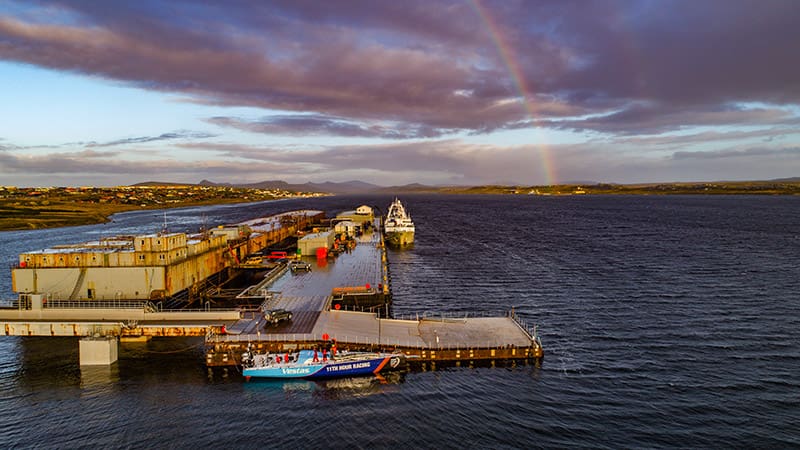
Compounding the challenge is the closeness of the racing. An easterly-moving front swept across the back of the fleet first, allowing them to turn towards the north (and the finish in Itajaí, Brazil) much sooner than leaders Brunel.
Dongfeng and third-placed team AkzoNobel profited massively from Brunel’s misfortune, shaving huge chunks off their lead in just a few hours.
Having sailed more than 6,400 gruelling miles, around half of those at the front of the fleet, Brunel is now locked in yet another fight for the top spot that could go down to the wire.
“It’s painful for us because the boats behind us got the shift first,” Bekking said. “We’re going to come all back together again, but that’s yacht racing… It looks like the finish of this leg will all come down to the last 200 miles, which we’ve seen so many times. It will be game on.”
Behind the top three, two teams are racing at less than full capacity. MAPFRE is back on track after suspending racing for 13 hours at Cape Horn to make repairs. Despite being 200 miles off the lead, the Spanish team now has the inside lane.
And Turn the Tide on Plastic is pushing forward with a reduced sail plan, after finding that a starboard side spreader root, a component used to attach the spreader to the mast, had moved. At one point, the team was assessing whether it would need to stop. But after consulting with the mast supplier, who modelled various scenarios, the current plan is to keep racing.
Skipper Dee Caffari said, “We are back in the game with double points on the scoreboard. Keep your fingers crossed.”
Meanwhile, Vestas 11th Hour Racing has now arrived in Port Stanley, Falkland Islands, after dismasting on Friday.
No one was hurt when the rig came down and the team was able to clear away the damage and proceed under its own power to the Falklands.
“I was driving at the time,” said navigator Simon Fisher. “There was a big bang and the rig broke just above the first spreader… The top of the mast landed in the water with the stump sticking up… To protect the integrity of the hull, we had to cut everything away.”
The Vestas 11th Hour Racing team is currently working through several logistical scenarios to re-join the fleet in Itajaí.
“It’s a challenge. The whole thing is a challenge,” said crew member Stacey Jackson. “Whether you are racing the weather or the elements or setbacks like this. I think it just tells the story that this race is about overcoming difficulties…”
Team Sun Hung Kai / Scallywag continues to make progress towards a landfall on the west coast of Chile, early next week.
19 April 2018
Six Volvo Ocean Race teams to take start of Itajaí In-Port Race
Six Volvo Ocean Race teams will be on the start line on Friday afternoon for the Itajaí In-Port Race in Brazil, with Vestas 11th Hour Racing joining the fleet following its dismasting, and subsequent repair and relaunching.
Team SHK/Scallywag, who only arrived in Itajaí on mid-afternoon on Thursday won’t be taking part as the team races the clock to prepare for the start of Leg 8.
This is the seventh event in the Volvo Ocean Race 2017-2018 In-Port Race Series.
The Spanish MAPFRE team, skippered by Xabi Fernández, is at the top of the leaderboard for the series, with two race wins and three second place finishes to boast the most consistent podium results.
But just three points back is Dongfeng Race Team, winners of three races, but held back by one disappointing result in the China stop.
The two Dutch-skippered entries, team AkzoNobel and Team Brunel are battling for the final podium spot, with Simeon Tienpont’s AkzoNobel squad just one point ahead of Bouwe Bekking’s Brunel.
The Volvo Ocean Race 2017-2018 In-Port Race Series acts as a tie-breaking mechanism for the overall race leaderboard. And with just one point separating first from second place after seven legs of racing, the results here could be crucial by the time the race finishes in The Hague at the end of June.
23 April 2018
Volvo Ocean Race Leg 8: fleet switches back to Race Mode
Volvo Ocean Race 2017-2018 Leg 8. Following a big send-off from Itajai, Brazil, on Sunday, the seven-strong fleet – back up to full complement with the welcome return of Vestas 11th Hour Racing and Sun Hung Kai/Scallywag – faced a tricky opening night of unpredictable weather.
There was little chance for the sailors to acclimatize slowly as constant variations in wind direction and strength meant numerous sail changes.
“It’s very unstable – the wind’s up and down by ten knots, and 30 degrees left to right,” said team AkzoNobel skipper Simeon Tienpont. “We’ve got plenty going on on deck, that’s for sure.”
Onboard Turn the Tide on Plastic, skipper Dee Caffari welcomed the slightly more stable conditions that greeted the teams with sunrise.
“The first night at sea is always interesting,” she said. “It takes a little while to get back into the routine and with all the boats so close together it can change the way you sail.”
“Even now at first light we can all see everyone clearly and we are all on the same sail combination doing the same thing. We had a few clouds in the early hours resulting in some wind shifts, some changes in pressure and some rain, but now the skies all seem a bit more consistent.”
MAPFRE were the early leaders in the opening hours but Xabi Fernandez’s crew were reeled in after they got caught out by a cloud.
“We’re all good here after a tricky start,” Fernandez said. “Over the night we’ve had a little bit of action and we lost our position a little bit.”
At 1300 UTC, and with just over 200 miles of the 5,700-mile leg ticked off, it was Turn the Tide on Plastic that topped the table, with Brunel in second and Scallywag, the most northerly boat, in third.
The more southerly-positioned Dongfeng Race Team, Vestas 11th Hour Racing, MAPFRE and AkzoNobel were in fourth to seventh respectively.
However the ranking is calculated to a series of waypoints without taking into account routing due to weather, and in reality less than five miles separate first to last place at this early stage.
While the Leg 8 finish line in Newport, USA, lies some 4,000 miles north, the teams are battling to get east as quickly as possible so they can hook into stronger breeze that will fire them around Brazil’s most easterly point.
Over the course of the day the breeze is forecast to weaken and shift to the right, forcing the teams into a tactical tacking battle as the sun sets.
25 April 2018
Tips and tricks – How to drive a Volvo 65 in extreme conditions. VIDEO
AkzoNobel’s Chris Nicholson describes how to helm a Volvo Ocean Race 65 in extreme conditions.
4 May 2018
Leaders Under Pressure as the Race closes up
Volvo Ocean Race 2017-2018 Leg 8: Bekking’s Dutch-flagged crew jumped into the top spot on May 1 after exiting the Doldrums and have so far defended their position despite spirited attacks from their rivals.
Twelve days into the 5,600-mile sprint from Itajaí in Brazil, the quick sailing through the trade winds was continuing Friday – although lighter winds lay in wait further down the track, meaning Brunel’s lead of seven miles is far from secure.
Bekking said his crew were making the most of the ideal conditions while they last.
“We are pushing to the max we can do,” the veteran Volvo Ocean Race sailor said. “We know we are sailing into less pressure so the boats behind us will keep gaining, annoying but a fact we have to live with.”
“Capey, our navigator, is relaxed in his own way, but can see and feel that it is game on. He makes I don’t know how many simulations for all the routes possible from here to Newport and we are discussing this together with Pete (Burling) as well.”
“Two very important factors are the high pressure system east of Bermuda and the Gulf Stream which runs from Florida into a north east direction towards Europe.”
“The current can run up to five to six knots. Unfortunately it is not one straight stream, it has big eddies, so if you do it wrong you can have five knots against you while another boat has five knots with them. But we are confident!”
Around 25 miles southeast of Brunel, Dee Caffari’s Turn the Tide on Plastic slipped out of the podium spots after hitting a patch of lighter wind.
As the seven teams drew level with Puerto Rico, Vestas 11th Hour Racing were able to skirt round the outside of them into third.
“Three disappointing position reports in a row is frustrating and could get you down,” Caffari said. “However, we will fight harder, we just need to let these rain clouds know…”
“During the early hours of this morning the rain clouds carried some squally action and huge shifts. One minute we were in 28 knots of wind heading towards the Caribbean and then the next moment we were lifted, towards the centre of the high pressure, in 14 knots of wind.”
“We can only sail in the conditions that we have and we are working hard but it seems everyone else’s clouds are more user friendly allowing them to keep gaining on us and we are slipping back.”
“If it is not the up and down and shifts of the wind then it is this Sargassum weed. Rudders no longer having smooth water flow lose grip and the boat spinning out is not fast.”
“We have two more days of this express highway and then the breeze will start to decrease before we gybe and sail on port. We then face a lot of action and sail changes between us and the finish from that gybe point.”
Out to the east of the leaders, MAPFRE and team AkzoNobel are in a dead heat for fifth place, about 45 miles off the lead.
Meanwhile, seventh-placed Team Sun Hung Kai/Scallywag clawed back miles on the leaders as they posted the best 24-hour distance run of the fleet, notching up 513 miles.
Scallywag crewmember Pete Cumming, racing in his first Volvo Ocean Race leg, said the crew had not lost hope of catching their rivals despite a 181-mile deficit on Brunel.
“We still believe it’s going to be close at the finish,” he said. “There’s going to be a transition close to the finish and our routing has us coming in a few hours behind the leaders.”
8 May 2018
MAPFRE made an Incredible Comeback in Newport: Good Job Guys!
The Spanish team MAPFRE stunned the Volvo Ocean Race 2017-2018 fleet on Tuesday morning by stealing a win in Leg 8, with a shocking come-from-behind victory in Newport, Rhode Island.
On Monday, with just 300 miles to go, MAPFRE was in fifth place.
As Tuesday morning dawned, and with the fleet ghosting towards the finish line in extremely light and shifty winds, Xabi Fernández’s team was among the leading quartet, battling in slow motion with Team Brunel, Dongfeng Race Team and Vestas 11th Hour Racing.
And even when the leaders were just 500 metres from the finish line, MAPFRE was still trailing Team Brunel as the pair emerged from the fog within sight of the spectators at the Fort Adams Race Village.
But on approach to the final turning mark, MAPFRE picked up a zephyr of wind to sneak past Brunel and claim what just moments earlier would have been seen as a very improbable leg win.
“This is unbelievable,” skipper Xabi Fernández admitted moments after crossing the finish line. “I can’t be happier. We were always hoping to come back a little bit but to be honest we were not expecting to win this leg, so we’re super happy”.
“Our hopes were always that there would be a compression so we could catch someone… Last night has been crazy how much everything has closed up and everyone on board did an amazing job.”
Bouwe Bekking’s Team Brunel, who had been leading for most of the past week after the equator crossing took a well-deserved second place finish.
Dongfeng Race Team, who had been ahead of the fleet on the approach to the east coast overnight Monday night, suffered the cruelest fate over the final miles.
Every break seemed to go against Charles Caudrelier’s team and after being in position to claim the leg win, the team had to settle for fourth place with Vestas 11th Hour Racing storming past Caudrelier’s crew in the final mile of the leg.
“This leg has had its ups and downs,” said Charlie Enright, the skipper of Vesta 11th Hour Racing. “We didn’t start great but we feel like we sailed pretty well for the middle two-thirds of the leg… Then with some positive input from some local knowledge, we end up back on the podium which is great.”
Newport is a homecoming for Enright and Nick Dana on Vestas 11th Hour Racing as well as Mark Towill who did his college sailing nearby.
“It’s awesome here,” Enright said. “It’s 0600 local time here and the amount of boats out is absurd. The amount of effort put in by Sail Newport and the stopover here is amazing.”
The final hours were painful for the exhausted sailors but extraordinary to watch. With the wind nearly shutting down overnight on the approach to Newport, the fleet found itself pushed around by the tide and currents near shore, at times even drifting backwards, away from the finish line.
This meant there was a high degree of uncertainty. Positions were never secure until the finish line was breached by MAPFRE. No one suffered more in the final miles than Dongfeng’s Caudrelier.
“We’re very disappointed,” he said. “We were dreaming about a victory here… But it makes me angry and I will be better on the next one. I am already focussed on the future and I promise Dongfeng will do a fantastic job on the next one.”
The shocking win by MAPFRE has a huge impact on the overall race leaderboard where MAPFRE has regained the lead from Dongfeng, and now sits three points clear at the head of the table. Brunel retains the third podium position.
The light winds near the finish resulted in a massive compression in the fleet, all the way back to SHK/Scallywag who were trailing the leaders by over 130 miles just one day ago. But as MAPFRE crossed the finish line on Tuesday morning, David Witt’s team was less than 20 miles behind.
22 May 2018
Volvo Ocean Race Leg 9: Team Brunel lead the Southerly Group
Volvo Ocean Race 2017-2018 Leg 9. Skipper Bouwe Bekking and his Team Brunel lead a southerly group of four boats who are taking advantage of stronger winds to open up an advantage as a split develops in the fleet.
To the north, wallowing in lighter conditions sit the overall race leaders, MAPFRE, as well as second-placed Dongfeng Race Team, and Turn the Tide on Plastic. Average speeds for these three have been in the 7 to 10 knot range for much of Tuesday morning UTC.
Meanwhile, the southerly quartet has been roaring along at over 15 knots, and at one point had opened up a 30-mile advantage over the northerners.
Bekking explains what is at stake:
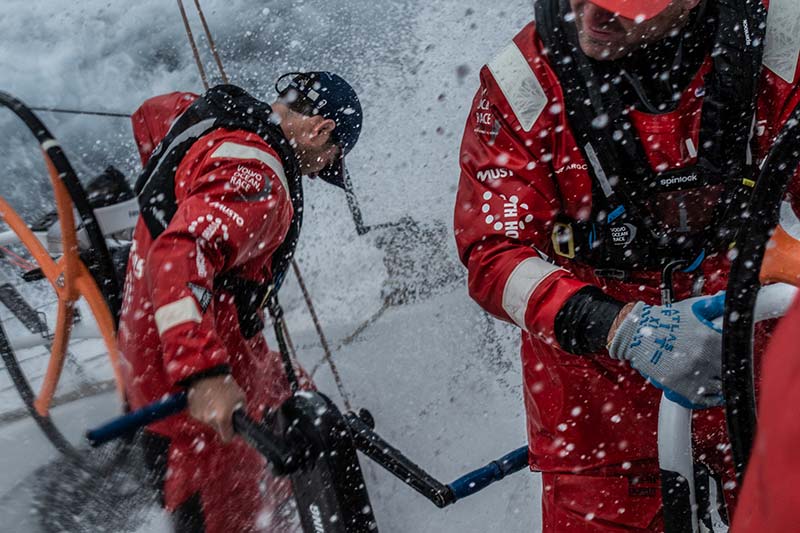
“As expected there is a big split in the fleet, so it will be interesting to see who comes out ahead in five days time,” he wrote in a blog to race headquarters. “We are taking the southerly route and have managed to stay ahead of the front, basically we have always more breeze than the forecast…”
“The boats in the north follow the great circle, the shorter route and will face lighter winds over the next 24 hours, but should have a little better current from the Gulf Stream. In the last report they had 6 knots compared to the 25 knots of wind we have, nervous times for them. But I think they will be alright in the long run. We’ve seen that before in trans-atlantics. We will also have to face the lighter winds and even have to tack tomorrow.”
And already, the gap is narrowing. As of 1230 UTC on Tuesday, speeds were up on Dongfeng, MAPFRE and Turn the Tide on Plastic, all of whom were sailing a more direct route to the finish than those to the south and therefore been narrowing the deficit on the ranking. With over 200 miles north/south separation, the leverage between the groups is enormous.
“It’s a massive split,” said MAPFRE’s Blair Tuke. “It’s a little bit of a worry that Brunel has so much separation from us. It could work out well for us but it might not… It’s one of those things where you have to sail the wind you’ve got. We’ve done that and we’ll have to see how it plays out through this transition as the new breeze comes in over the next day or so.”
For all the fleet, the conditions of Volvo Ocean Race 2017-2018 Leg 9 have been more pleasant than anticipated, with the Gulf Stream providing warm temperatures to make life on board more comfortable.
“We have enjoyed flat water, warm conditions and we have managed to keep moving,” Turn the Tide on Plastic skipper Dee Caffari wrote. “We have light winds ahead and by this evening we will be in new breeze on the other gybe that will increase. This low pressure we will ride for a few days so we need to push hard while we have it and hang on in there.”
29 May 2018
Volvo Ocean Race Leg 9: 3 Teams in 3 Points, the Gloves are Off
The top three teams in the Volvo Ocean Race 2017-2018 are within three points after Bouwe Bekking’s Team Brunel won Leg 9 into Cardiff, Wales to vault into contention for the overall race win.
The Leg 9 results also mean a new team is at the top of the race leaderboard as Dongfeng Race Team, with a third place finish, take overall race honours by just a single point over MAPFRE, who settled for a disappointing fifth place finish on the transatlantic leg.
With the win, Bekking’s Brunel is just three points off the lead, meaning the final two European legs will be more important than ever. Although Brunel sits in third place this morning, the Dutch entry is riding a wave of momentum.
Since the team hit a low point at the conclusion of Leg 6 after arriving in Auckland with a sixth place finish, Bekking and crew have posted a 1-2-1 scoreline, including important wins on the final two double-point scoring legs, to move from also-ran status on the leaderboard to holding down a firm grip on a podium position with an eye on the top spot.
“We’re very happy with the result – to beat the two red boats (Dongfeng and MAPFRE) was the objective,” Bekking said after crossing the finish line. “Winning of course is nice, as well as to get the bonus point and then a nice fight to beat AkzoNobel in the end as well, so we’re a happy team“.
“But the aim is to keep looking forward. We’ve closed the gap to MAPFRE and Dongfeng and victory remains our main objective.”
To earn the leg win, Bekking had to fend off fellow Dutch skipper Simeon Tienpont’s team AkzoNobel, who had held a nominal lead of a few hundred metres just hours before the finish.
But in the strong currents and light winds of the Bristol Channel, Bekking and his crew found a way to claw back in front and then protected over the final miles to take the win by just 4 minutes and 05 seconds over team AkzoNobel.
For Tienpont’s AkzoNobel, Volvo Ocean Race 2017-2018 Leg 9 will be long remembered for the amazing record-breaking effort the team made in setting a new standard for 24-hour distance run in the Volvo Ocean Race.
On Friday May 22, in ideal conditions, the team AkzoNobel crew obliterated the previous race record set in a Volvo Ocean 70 by Ericsson 4 in 2008. The new mark is a 602.51 nautical mile, 24-hour run.
9 June 2018
Volvo Ocean Race Final Sprint: Every Point Counts
The pressure is building as teams prepare for the penultimate leg of the Volvo Ocean Race 2017-2018. Every point counts on the final sprint to the finish.
With just two legs remaining in the Volvo Ocean Race the battle for the overall prize is tighter than ever, with three teams fighting for first place and a fourth crew still in with a shot at the podium: every point counts.
As the team’s prepare for the Sunday afternoon start of Leg 10 sprint from Cardiff, Wales to Gothenburg, Sweden, Charles Caudrelier’s Dongfeng Race Team has the advantage, sitting in pole position. The Chinese-flagged team holds a one point lead over Xabi Fernández’s MAPFRE, who had been leading for the majority of the race.
And just two points further back is the hottest team in the race, Bouwe Bekking’s Team Brunel.
To put in context how dominant Bekking’s team has been over the past three legs, consider Brunel has scored 37 of the maximum 38 points available, compared to Dongfeng with 26 points and MAPFRE who have collected 20 points over that span.
“All the pressure is on these guys, they’re still ahead of us,” Bekking insisted at Friday’s press conference. “We just have to beat them, like I said in Newport. Just beat the two red boats and then we’ll see what happens on the last leg. I think it will all come down to the last leg into The Hague.”
As much as he’ll be fighting for the prize, Bekking will need to keep one eye on his Dutch compatriots on team AkzoNobel, who could challenge for the podium with two strong results on the finishing legs.
“Earlier in the race, maybe we played too much in match racing with MAPFRE,” Caudrelier conceded. “Now there is another boat in the game. We just have to go race and see what happens. Maybe after his leg we’ll have to think about controlling someone but right now, the lead is too small for that.”
Leg 10 of Volvo Ocean Race 2017-2018 is a 1,300-nautical mile sprint that takes the teams around the west coast of Ireland up to the northern tip of Scotland before heading east-southeast to Gothenburg, the home of Volvo.
15 June 2018
Team Brunel Comeback. The Final Leg will Determine the Winner!
Team Brunel has completed one of the great comebacks in sailing, setting up an epic final leg to The Hague next week in what will be the closest Volvo Ocean Race in history.
Three teams – MAPFRE, Team Brunel and Dongfeng Race Team – will start the final leg of the Volvo Ocean Race 2017-2018 in a dead heat at the top of the table, with the overall title on the line. It’s an unprecedented scenario in the 45-year history of the race.
On a rainy, blustery Thursday evening in Gothenburg, skipper Bouwe Bekking led his Team Brunel to a come-from-behind win in Leg 10 over Xabi Fernández’s MAPFRE squad, who claimed second place, less than two-minutes behind after nearly 1,500 nautical miles of bow to bow racing.
“We did a fantastic job as a team and of course the result was better than we could have dreamed,” Bekking said. “We wanted to beat the two red boats but a win to get the bonus point is really nice…”
“The pressure was on but we knew we just needed to sail the boat the best we could and not do any crazy things. Very happy how it all ended up.”
Bekking has led his team on an incredible comeback pace, following a dismal opening half to the race. At the conclusion of Leg 6 into Auckland, the team was mired in sixth place, on just 20 points. In comparison, MAPFRE, the race leader at the time, had already won 39 points.
But since then, Team Brunel has been on fire, posting a 1-2-1-1 scoreline over the past four legs of the Volvo Ocean Race 2017-2018, to bully its way to equal first at the top of the leaderboard, after collecting 45 out of a possible 47 points, an incredible scoring ratio.
The Leg 10 results mean MAPFRE and Team Brunel sit equal at the top of the leaderboard with 65 points. MAPFRE will be ranked in first place by virtue of leading the In-Port Race Series, which is the tie-break mechanism for the Volvo Ocean Race.
Charles Caudrelier’s Dongfeng Race Team, who was the leader at the beginning of Leg 10, had a fourth place finish into Gothenburg, putting Dongfeng on 64 points (although the team is in pole position to earn an additional bonus point for best elapsed time which will be added after the Leg 11 finish).
This means the top three boats in the Volvo Ocean Race 2017-2018 will start the final sprint into The Hague on June 21 in a dead heat, with the overall title on the line.
“For the fans it’s going to be an exciting last leg,” said Caudrelier after the finish. “And for us as well. We will give all we have and try for our first leg victory. But really we just have to be ahead of the other two. We can do it!”
“It was a very good leg for us and a good result as well, but a little bit painful the way it happened,” Fernández said. “We felt we did the hardest part of the leg, up the coast of Scotland, and managed to be in the lead there, but we just couldn’t hold Brunel on the tight reaching… They’ve been improving a lot on the last legs, but it was a surprise to see such a speed difference.”
Team AkzoNobel was third into Gothenburg, another strong podium finish for Simeon Tienpont’s team.
“I don’t think you can get any better racing than this in the sport of sailing,” he said. “It was intense racing in the most competitive fleet you can find in the world. Pretty stoked to have a podium. We pushed to be first but MAPFRE and Brunel did an unbelievable job and we had to let them go.”
Turn the Tide on Plastic had a strong leg, battling with the leading group from start to finish. In the end, Dee Caffari’s squad would take a fifth place finish, moving them to within one point of over-hauling Scallywag.
“We’ve been racing in sight of five boats for the entire leg,” Caffari said at the pontoon after finishing. “To have the racing that closes right up until the finish is immense…”
“We were ahead of AkzoNobel and Dongfeng at times but they put the afterburners on at the end and we couldn’t quite hold them. But we were really competitive and I’m very proud of my team.”
It was an uneventful, if disappointing leg for Charlie Enright’s Vestas 11th Hour Racing squad, who posted a sixth place finish.
“It was a tough leg and not our best performance by any means, but we have one more leg to end it on a high note,” Enright said. “We were pushing right until the end. It was our worst result with a sixth place, but the deltas were really close. We were battling with Brunel who ended up winning the leg and we were pushing hard until it was a foregone conclusion.”
David Witt’s Sun Hung Kai/Scallywag finished in seventh place, after falling behind the fleet on the first evening and never fully recovering into a competitive position.
“We made it pretty hard for ourselves being anchored in Cardiff while we watched the rest of the fleet sail away from us for 100 miles,” Witt said.
“But I’m really proud of the team and I know the boss is too. I’ve been involved in team sports all my life and I’ve never seen a group of people who keep rising and work harder when it starts to get hard. We’ve had our ups and downs but we’re going to do our best in the last leg.”
But all eyes will be on the top three boats for the start of the final leg as they battle for their positions on the podium for this edition of the Volvo Ocean Race. The results have never been closer and the pressure has never been higher.
Leg 11 of Volvo Ocean Race 2017-2018 from Gothenburg to The Hague features a fly-by dogleg past Aarhus, Denmark, and starts at 1400 local time in Gothenburg (1200 UTC) on 21 June, 2018.
22 June 2018
Volvo Ocean Race Leg 11? No, You Can Call It Match Race
Rivals Dongfeng Race Team and MAPFRE were locked in a bitter tussle for the Volvo Ocean Race 2017-2018 Leg 11 lead – and overall Volvo Ocean Race victory – on Friday as they led the fleet towards the Danish city of Aarhus.
One third of the way through the 970-mile sprint final leg from Gothenburg to The Hague the seven teams were today split by less than 20 miles as they charged south through the Kattegat, the strait separating Sweden and Denmark.
After rounding the first course mark off Norway overnight, the leading pair profited from better breeze than their counterparts and extended the gap at the front.
With the second mark at Aarhus, on Denmark’s east coast, just 10 miles away, the two red boats were just one-mile apart as of 1200 UTC, keeping alive the battle that will grant overall race victory to whichever of Dongfeng, MAPFRE and Team Brunel finishes ahead of the others.
Their closest rivals on the race course, Vestas 11th Hour Racing, were a little under six miles back, in third place, while Brunel held down fourth but have work to do to narrow a gap of over 15 miles.
As well as being a monstrous battle between the crews, the race for the overall title is also a personal one.
Charles Caudrelier skippered Dongfeng to third spot in the 2014-15 edition, while Brunel, under race veteran Bouwe Bekking’s leadership, finished second.
MAPFRE skipper Xabi Fernández has raced four times but never lifted the trophy.
What’s more, if MAPFRE or Team Brunel win the race, either MAPFRE’s Blair Tuke or Brunel’s Peter Burling will become the first sailor ever to complete the ‘triple crown’: victory in the Olympics, the America’s Cup and the Volvo Ocean Race.
But one-third of the way through the challenging Volvo Ocean Race Leg 11, the focus has narrowed to the next manoeuvre, the next transition.
“This downwind section has been pretty tricky – in general there’s been a big extension,” MAPFRE’s Tuke said.

“We’ve gained quite a lot on Brunel, AkzoNobel and Vestas. We’ve managed to stay close to Dongfeng but for a little while it was pretty scary – they managed to get five or six miles in front of us. As we’ve come into Denmark we’ve compressed again.
“We’re now on one of our fastest sail setups, so all’s good but hopefully we can catch up even more, and, at some stage before The Hague, pass them.”
On Brunel the crew were cursing their luck as they watched the gap to the frontrunners grow – but had faith in the forecast which predicts the wind to drop coming into Aarhus, providing an opportunity to catch up.
“It’s been a case of ‘the rich get richer’ since rounding the mark off Norway,” Burling said. “The fleet’s been expanding a little, but there should be a pretty good compression as we come into Aarhus. Hopefully we can catch up with them again.”
Skipper Bouwe Bekking added: “We didn’t sail too smart yesterday afternoon and that has become expensive. At the rounding mark off Norway still in good contention, but then it went backwards. We will keep fighting until the end.”
Onboard Dongfeng, the crew were taking nothing for granted.
“We’ve sailed really nicely against MAPFRE and they’re still behind us,” Dongfeng watch captain Daryl Wislang said. “Let’s hope it can stay like that. It’s going to be a battle that’s for sure.”
After rounding the Aarhus mark the fleet will then head north to a virtual mark close to the Norwegian coast, which they will leave to port, before beginning the run south into the Leg 11 finish line at the Dutch capital of The Hague.
Behind the leading group, the battle for sixth place on the Volvo Ocean Race 2017-2018 overall leaderboard continues between SHK/Scallywag and Turn the Tide on Plastic. Currently, the pair are sailing bow to bow with a slight edge to the Scallywags.
25 June 2018
Dongfeng Race Team Win the Volvo Ocean Race in the Closest Finish in Race History
Dongfeng Race Team win the Volvo Ocean Race 2017-18 in the closest finish in race history. Skipper Charles Caudrelier led his team to victory on the final leg of the race, a 970-mile sprint from Gothenburg, Sweden to The Hague.
Incredibly, it marked the first leg win for the team – it couldn’t have come at a better time.
Three teams started Volvo Ocean Race 2017-2018 Leg 11 of the race on Thursday in a dead heat on the overall leaderboard. The finishing order between MAPFRE, Team Brunel and Dongfeng Race Team at The Hague would determine their place on the overall race podium.
Each of those three teams led at various points on the leg and had their opportunities to grab the prize.
But it was Caudrelier and his crew who made a bold call on Saturday evening to take a coastal route to the finish, which squeezed them tight against the shoreline and separated from the other leaders by a series of Exclusion Zones.
The decision hurt the team in the short term as they tumbled down the leaderboard. But by Sunday morning, with less than 100 miles left to race, weather routing projections had the top boats finishing within minutes of each other. None had been able to break away overnight, despite the significant splits on the racecourse.
“We knew that we would fall behind initially and that if it came good it would only be at the end. The last position report (1300 UTC on Sunday) we were 27-miles from the finish and they were 20-miles and we thought it was over. But then I did a small weather routing and it showed we could end up one-mile ahead so I woke everyone up and said, ‘let’s push!’”
As the teams finally converged again on Sunday afternoon, just a few miles from the finish, it was Dongfeng Race Team, flying down the coast from the north sliding in front of the offshore group, to earn their first leg win, propelling Caudrelier’s team to overall victory.
“We always trusted each other. Nobody thought we were going to win this last leg, but I had a good feeling,” an emotional Caudrelier said, after thanking his supporters and team. “I said ‘we can’t lose, we can’t lose, we can’t lose’… and we won!”
The overall results make this the closest finish in the 45-year history of the race and marks the first win for a Chinese-flagged team. It also means Carolijn Brouwer and Marie Riou were on board as the first women sailors to win the Volvo Ocean Race.
Xabi Fernández’s MAPFRE was third on the leg, which put the team into second overall.
“It has been tough,” Fernández admitted. “We sailed very well the whole way around the world and on this leg as well, so naturally we’re a bit disappointed. We were very, very close this time, but it was not quite enough. So we have to say congratulations to Dongfeng who sailed a little bit better than us.”
Team Brunel skipper Bouwe Bekking would have liked nothing more than to win the race for the first time in eight tries with a home finish in The Netherlands. But it wasn’t to be. His fourth place leg finish left the team in third place overall.
“Third place, still on the podium, I think we can be pretty proud of that as a team,” he said. “We thought we had made the right choice (to go further offshore) and we expected a windshift. It came 90-minutes too late and that was the race. But that’s yacht racing. And of course we have to congratulate Dongfeng and MAPFRE for their results.”
Second place on the final leg of the Volvo Ocean Race 2017-2018 into The Hague was Dutch skipper Simeon Tienpont and his team AkzoNobel, who had previously secured fourth place on the overall leaderboard.
“It’s incredible to finish on the podium in our hometown,” Tienpont said. “We would have loved to have been fighting into The Hague for the final podium but to have set the 24-hour speed record and to get six podium finishes in the race is a testament to the job everyone on our team – on the boat and on shore – have done.”
Vestas 11th Hour Racing had already been locked into fifth place on the scoreboard and after a promising start to Leg 11, had a disappointing seventh place finish on the leg.
“We have a great group of folks on this team,” skipper Charlie Enright said. “We’ve been through a lot and I’m not sure any other group could have dealt with the challenges we have faced the way we did. It’s something special and we’re going to continue to work together moving forward. This was a tough way to go out certainly, but we have one more opportunity with the In-Port Race this weekend.”
That In-Port Race, scheduled for Saturday afternoon, will determine the sixth and seventh place positions in this edition of the Volvo Ocean Race. Both SHK/Scallywag and Turn the Tide on Plastic finished the Volvo Ocean Race on equal points.
The tie-break mechanism is the In-Port Race Series, where David Witt’s Scallywag team currently holds the lead. But Dee Caffari’s Turn the Tide on Plastic is just three points behind and a strong finish on Saturday could lift them off the bottom of the leaderboard.
“We can’t help but smile today. We’ve done it,” said Caffari. “This leg was like the longest In-Port Race ever. A lot of corners to go around, and we gave it 100 per cent and left nothing in the tank.”
For David Witt, the finish was bittersweet the loss of John Fisher overboard in the Southern Ocean top of mind.
“I have very mixed emotions right now,” Witt said dockside immediately after finishing. “I’m incredibly proud of our team both on and off the water. We’re very tight and we have gone through a lot… But I’m also sad of course. I didn’t finish it with my best mate (John Fisher) who we started with. So very mixed emotions, but I’m glad we finished it.”
10 July 2018
The closest Volvo Ocean Race in the 45-year history of the event in 720 seconds
This edited video will take you through the closest Volvo Ocean Race in the 45-year history of the event. Seven teams, with the best sailors in the world, racing for 45,000 nautical miles, with the outcome only decided in the final few miles…
Volvo Ocean Race 2017-2018 was one of the closest and most exciting ever – with the winner decided in the final five miles of the race following a 45,000 mile marathon slog around the planet. Here’s a look at the race in all it’s glory – the highs and lows – as the teams put everything on the line in a bid to win sailing’s ultimate prize.
There has never been a dull moment, the competition has always been tight and the results open until the very end. It was the closest finish in the history of the race, and marked the first victory for a Chinese-flagged team.
As the ultimate test of a team in sport, the 13th edition of the race delivered challenges, emotions, and highs and lows to all the sailors and teams. This video captures all of the action and emotion.
28 November 2018
The Volvo Ocean Race 2017-18 in numbers
The latest edition of the Volvo Ocean Race, which started in Alicante, Spain in October 2017 and finished in The Hague in the Netherlands in June 2018, will be remembered as the closest in race history, as well as a record-breaking event on many levels.
After racing 45,000 nautical miles around the world, three teams embarked on the final sprint leg to The Hague with an opportunity to claim the title. And it wasn’t until the final moments that skipper Charles Caudrelier’s Dongfeng Race Team emerged as the leader ahead of Team MAPFRE and Team Brunel to grab the top step on the podium.
There had never been a race like it over the 45-year life of the race. At the conclusion of 126 days of racing, the winning margin was just 16 minutes.
But apart from the action the water, the 2017-18 edition of the race was setting records elsewhere as well. More than 2.5 million fans attended the race stopovers, putting the Volvo Ocean Race in the top tier of international sporting events, while new marks were set across all aspects of fan engagement and media coverage.
The Volvo Ocean Race 2017-18 in numbers:
(with direct comparison to 2014-15 race numbers, wherever possible)
- 23 female sailors in the race – the most ever – including three who sailed with the Dongfeng Race Team and became the first women to win the race
- 2.5 million people visited the 12 Race Villages (+4% over previous race)
- 94,200 corporate guests (+26%) attended functions during the race period including over 6,500 participants in the Guest On Board programme
- Over 3,300 hours of television broadcasting generated €429-million in publicity value (+46%)
- There was a cumulative TV news audience of 2.2 billion (+45%)
- 194 hours of live coverage was produced
- 1.9 billion social media impressions, including 200 million video views
- 13.7 million social media likes
- Over 400,000 comments on Instagram posts
- Over 1 million comments on race content on Twitter and 9 million retweets
- The average viewing time per video on YouTube was over 9 minutes
- The average Facebook post reached 398,000 users
- The most popular social media video was viewed over 23-million times
- Social media publicity value was €71-million
- 71,000 online articles (+10%) and 7,500 (+4%) print stories generated €95-million in publicity value
- www.volvooceanrace.com hosted 174 million page views (+72%) with visitors spending an average of over 4:20 (+149%) on the site
- The official app was downloaded over 537,000 times (+38%)
- The official race tracker hosted 111 million unique sessions (+186%)
- The digital TV (OTT) audience was 342 million, generating €67.8-million in publicity value
- Over 4,300 media accredited to cover the race (+4%)
- From its base in Lisbon, Portugal, The Boatyard provided a 15-week, 6,000+ man-hour refit to each of the seven one-design VO65 race boats ahead of the start, preparing the fleet for the closest race in history
- Hosting the race start in Alicante contributed €96-million to the Spanish economy and generated 1,696 full-time equivalent jobs
** Media number analysis by SMG
